
- Plan Your Visit
- Hours & Admission
- Getting Here
- Photography
- Gift Shop is temporarily closed.
- Arboretum Library
- Gardens & Landscapes
- Plant Collections
- Bloom Calendar
- Historic Structures
- Baldwin Lake
- Crescent Farm

Ask an Expert
- Adult Programs
- Kids & Families
- Teachers & Schools
- Admission Tickets
- Members Free with Card
- Arboretum Annual Report 2022
Become a Member or Renew
- Gala 2023: Cheers to a Great Night!
- Arboretum Benefactors
- Tributes & Memorials
- Planned Giving
- Commercial Photography
- Television and Movies
- Special Occasions
- Corporate Events
- Peacock Café
- Land Acknowledgement
- Annual Report 2022
- Employment Opportunities
Friday, May 13; 11:00AM - 12:00PM
About This Event
A tram tour is the perfect way to learn about the Arboretum’s history, view a variety of landscapes and be introduced to the many plants in our 127-acres. The 40-minute continuous narrated tram tour begins and ends at the Gift Shop patio.
Trams tours are offered : Wednesday – Friday*
Tour times: 11am and 2pm*
*Due to weather, special events, holidays and other factors the tram schedule is not guaranteed and schedule is subject to change . Please call on the day of your visit to verify tram availability at 626 821 3222.
Cost: Adults/Children/Seniors are all $8 per seat. Children under 3 who ride on parent’s laps are free. The tram can accommodate 34 people. Tickets are available on a first-come, first -serve basis and cannot be reserved in advance.
Where to purchase tickets: Tram tickets are available at the entrance check-in starting at 9am. Credit Card purchases only. Tickets are sold on a first-come, first-serve basis. Tickets cannot be reserved in advance.
Wheelchair availability: The tram can accommodate one wheelchair per tram tour. Please let the front desk know if you will need a wheelchair seat. They are available on a first come-first-served basis. Advanced reservations are not available.
Strollers, walkers and large bags : Please be aware that the tram may not accommodate these items when it is full, storage is not available on site.
Tram etiquette: We ask that phones are not used during tour and conversations are limited so that everyone can enjoy the narration.
Tram $8 per person Regular admission applies
© 2024 Los Angeles County Arboretum and Botanic Garden • 626.821.3222 • 301 North Baldwin Ave, Arcadia, CA 91007
The Arboretum on Facebook »
The Arboretum on Twitter »
Subscribe to the Arboretum Newsletter »
The Arboretum Flickr Group »
© 2023 Los Angeles County Arboretum and Botanic Gardens
Phone: 626.821.3222
301 N. Baldwin Ave, Arcadia, CA, 91007
Visit the Arboretum
301 North Baldwin Ave Arcadia, CA 91007
View in Google Maps »
The Arboretum is located south of the 210 Freeway. Exit South on Baldwin Avenue.
9am-7pm with last entry at 6:30pm. Member early entry 7:30am. Closed December 25.
Search the Arboretum
Hours: 9am-7pm with last entry at 6:30pm. Member early entry 7:30am. Closed December 25.
301 North Baldwin Ave Arcadia, CA 91007 Phone: 626.821.3222 View in Google Maps »
The Arboretum is located south of the 210 Freeway. Exit South on Baldwin Avenue.
Please purchase online prior to visiting.
General Admission Online Tickets
Adults $15.00 Students with ID and Seniors (62+) $11.00 Children Ages 5-12 $5.00 Children 4 and under free Members free with card
Reserve Free Day Tickets
Advance reservations are required for Free Day at the Arboretum, the third Tuesday of each month.
Member Sign In
Digital Membership Card
Gift Memberships
Gift Certificates
Member FAQs
Reciprocal Gardens
Stay in Touch!
Arboretum newsletter.
Sign up for the Arboretum Monthly Newsletter to learn about exciting events, new classes, and all the latest news from the Arboretum!
Email the Arboretum
Send your questions and feedback to the Arboretum Staff.
Do you have a question about plants? Our Arboretum gardening experts are available to answer all of your gardening questions.
A new spring temporary traffic plan begins on Wednesday, March 27th that impacts traffic flow and parking. Click here to learn more.

General Online Donations
Support FONA with a gift of any amount.
Become a FONA member starting at $45 and receive exclusive perks.
David Fairchild Society
A passionate community of supporters with membership starting at $1,200.
Grow the Garden Campaign
Donate to help us renovate the Washington Youth Garden. This project will make the garden more engaging, accessible, and productive.
Other Ways to Support
Support FONA through securities, donor-advised funds, planned giving, bench donations, and more.

TEMPORARY SPRING TRAFFIC PLAN
Beginning Wednesday, March 27th through mid-May, the Arboretum will implement a temporary traffic plan that impacts traffic flow and parking throughout the grounds. We urge visitors to plan their weekend visit as early in the day as possible or visit on a weekday to avoid crowds.
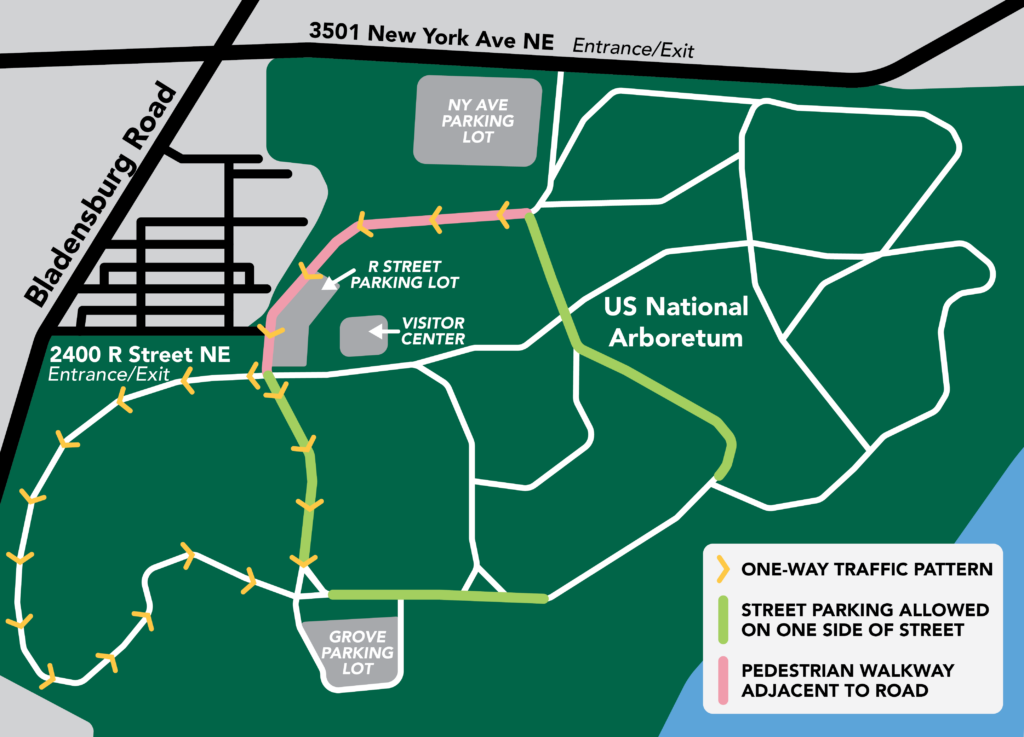
Click image to view the full map.
- One-Way Traffic Flow: Vehicles will only be allowed to travel one way down Hickey Lane and Eagle Nest Road, beginning at the intersection of Hickey Lane and Valley Road and continuing to the intersection of Eagle Nest and Azalea Roads. Azalea Road will also become a one way lane. All other traffic patterns will remain unchanged.
- Pedestrian Walkway: A pedestrian pathway will run adjacent to vehicle traffic on Hickey Lane, beginning at the intersection of Hickey Lane and Valley Road and continuing to the R Street Entrance.
- On-Street Parking: Vehicles will be allowed to park on one side of the road ONLY in designated areas along Eagle Nest Road, Azalea Road, and Valley Road. Signs will designate where parking is allowed.
Pedestrians and bicyclists are not subject to traffic restrictions, but please take special care when traveling around the one-way loop that is open to traffic.
The adjacent map illustrates the impact of this traffic plan on the grounds. Both the R Street and New York Avenue Entrances will operate as normal . Please drive carefully through the R Street Neighborhood and be respectful of our neighbors when accessing the R Street Entrance. Thank you for driving safely through the National Arboretum this spring.
WHAT TO SEE
The U.S. National Arboretum is a research institution, public garden, and green oasis of 451-acres that sits on the shores of the Anacostia River in Washington, DC. Annually, over 650,000 visitors enjoy connecting with nature, plants, and science. Its science has resulted in important plant introductions resistant to disease and pests that benefit our nation’s plant nursery landscape.
Established in 1927, the Arboretum is administered by the Agricultural Research Service (ARS) within the U.S. Department of Agriculture.
Arboretum Collections
In addition to the collections described below, the Arboretum contains striking collections of boxwoods, daffodils, daylilies, dogwoods, hollies, lilacs, magnolias, and maples.
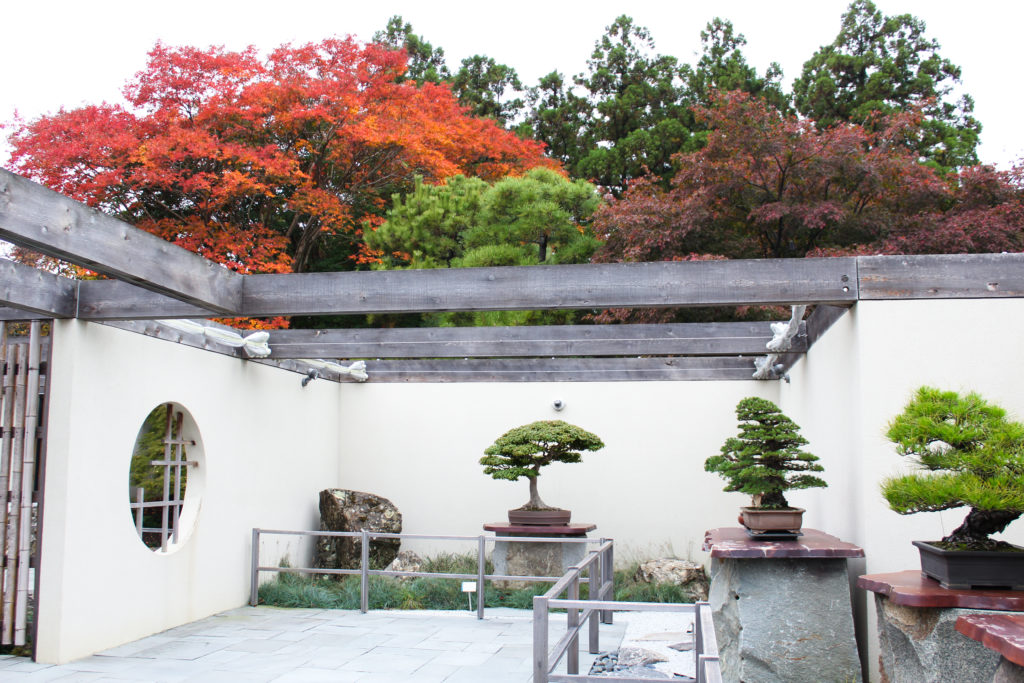
National Bonsai & Penjing Museum
This tribute to the history and beauty of bonsai is home of hundreds of bonsai trees, some of which are centuries old.

Introduction Garden
This garden showcases some of the many cultivars introduced by the National Arboretum and contains a koi pond that is a long-time favorite with kids.
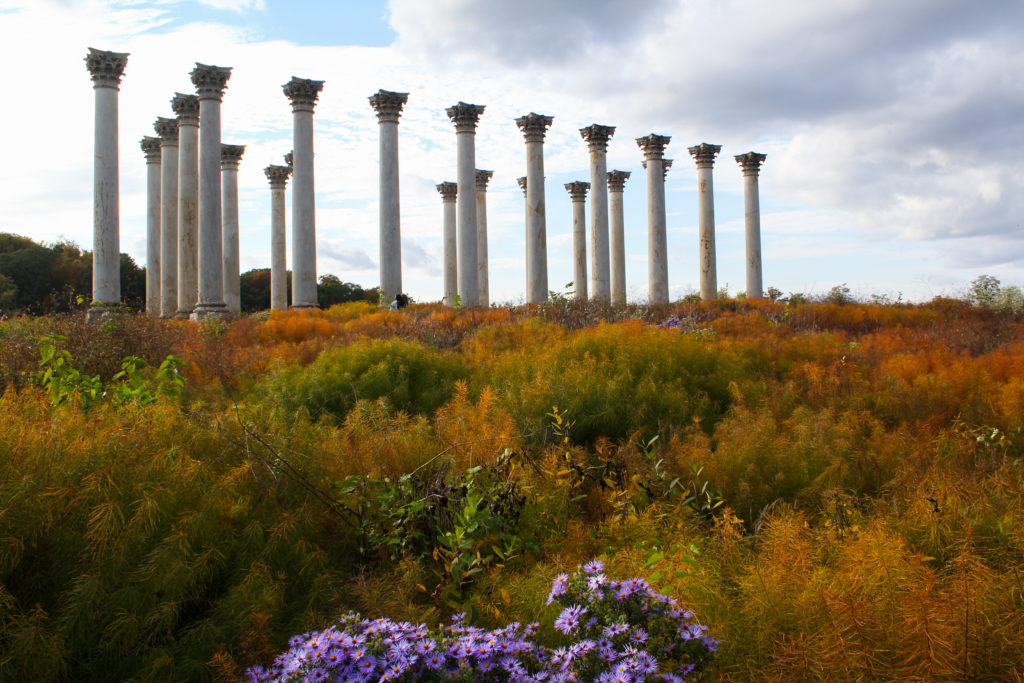
Capitol Columns
Originally part of the East Portico of the Capitol Building, these columns now create a captivating space overlooking a beautiful meadow.
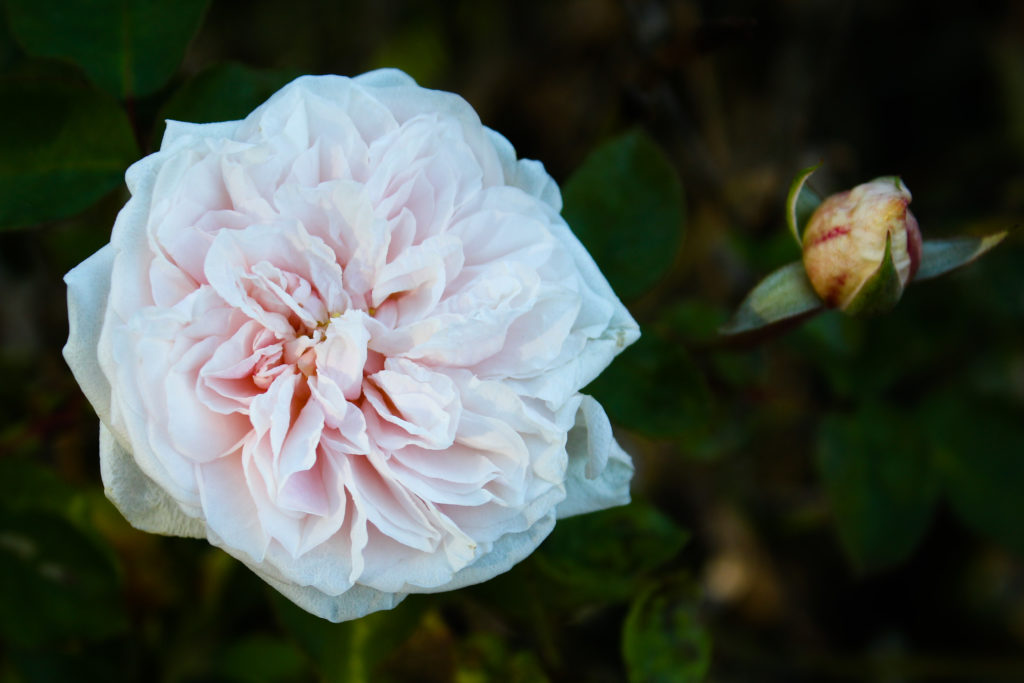
National Herb Garden
The largest designed herb garden in the United States includes a traditional knot garden, a rose garden, and 10 beds organized by themes.
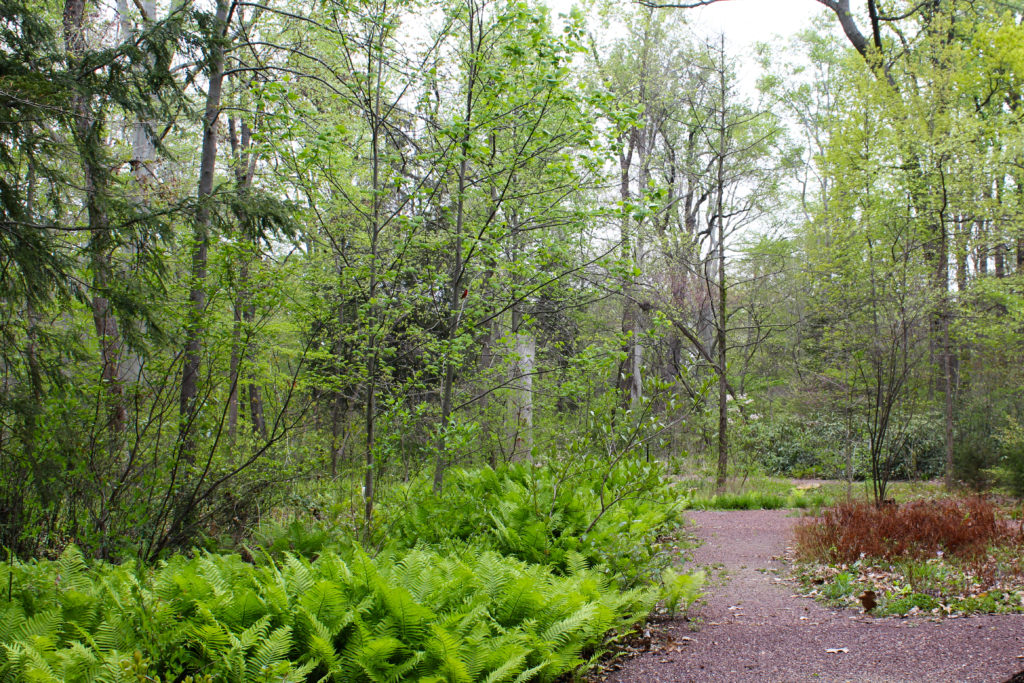
Fern Valley
Visitors can follow shaded paths through a woodland area filled with native plants from the eastern United States.
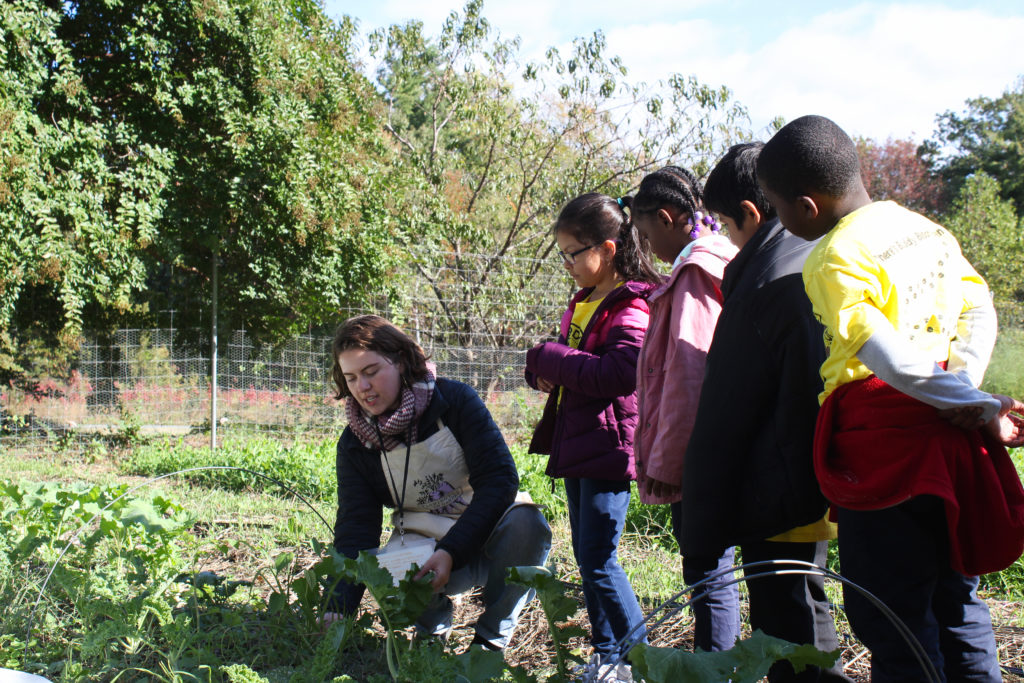
Washington Youth Garden
Our very own children and family-friendly garden grows a variety of food crops. Visit the WYG page for more information.
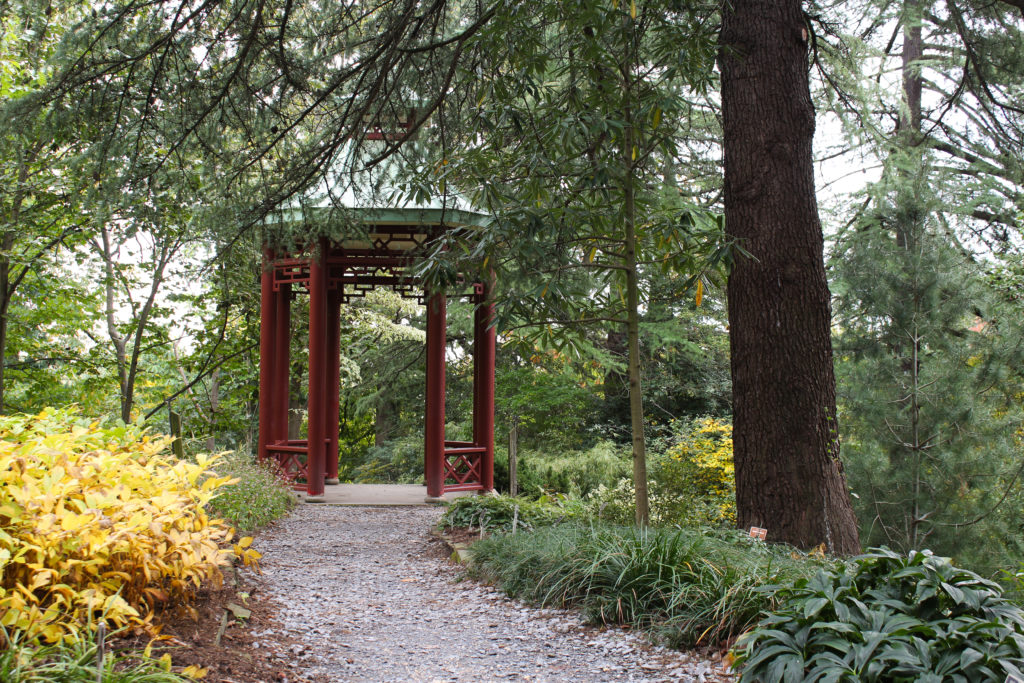
Asian Collections
These collections are home to a winter-blooming Camellia Collection and plants from China, Japan and Korea.
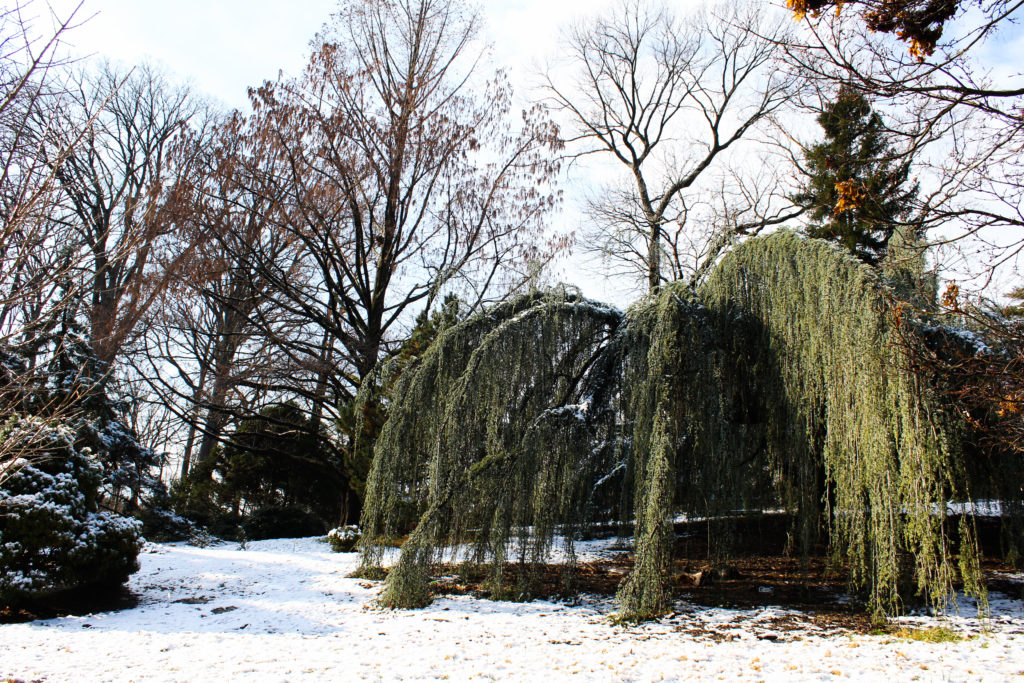
Gotelli Conifer Collection
A wide variety of dwarf and slow-growing conifers are interspersed with 31 of the Arboretum’s crapemyrtle cultivars.
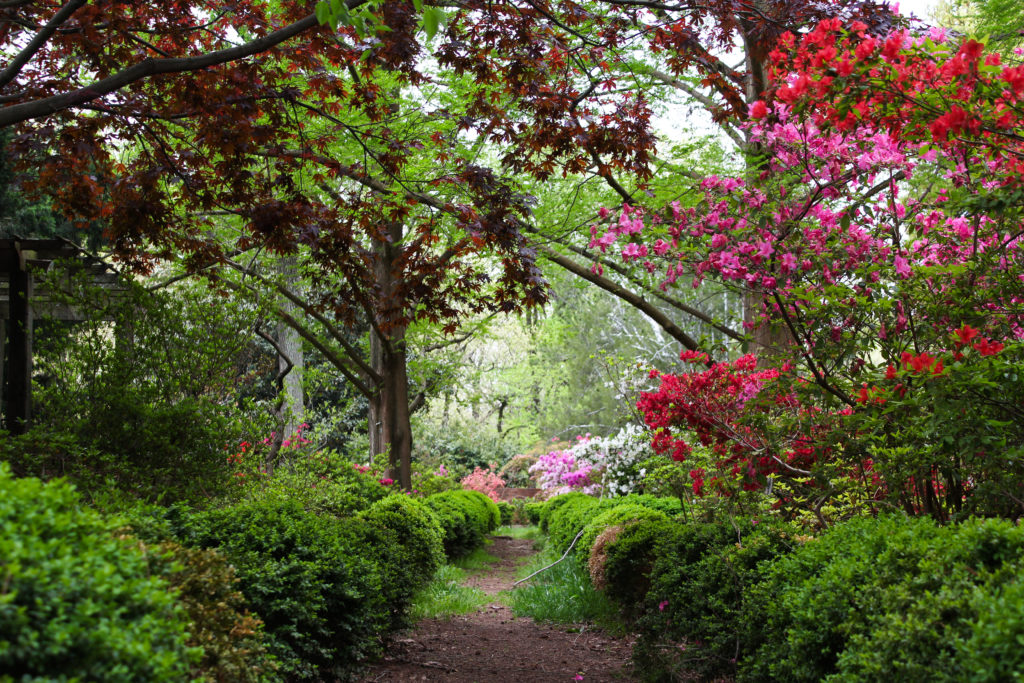
Azalea Collections
With thousands of azalea plants, these collections are the reason the grounds were first opened to the public.
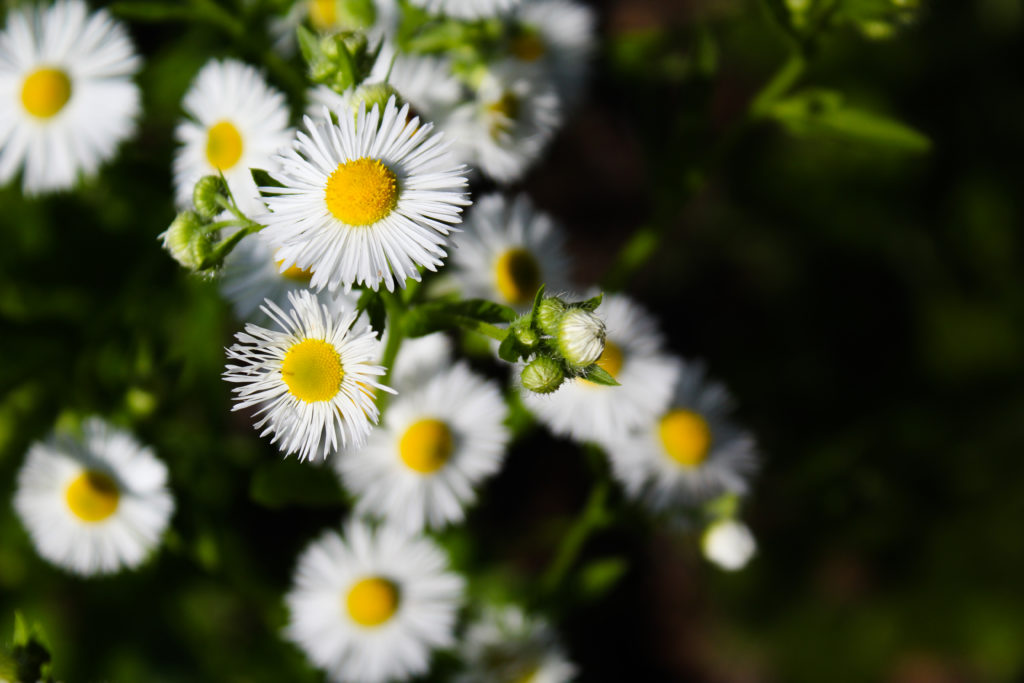
Friendship Garden
Surrounding Arbor House, where our office is located, this garden is low-maintenance and environmentally friendly.
Explore the National Arboretum’s website
Gardens and Collections
Map of Grounds
Photography FAQs
PLAN YOUR VISIT
Photography, permit required.
Please note that the following may require a USNA photography permit: special occasion photography; individual and group portrait photography; commercial and promotional photography; and photography that includes subjects, props, models or anything more than the natural and cultural resources of the National Arboretum.
R Street Entrance + GPS
2400 R St NE Washington, DC 20002
This gate is closed to vehicles from 2 PM to close on Monday through Friday. Pedestrians and bicyclists may use this gate at any time the grounds are open.
New York Avenue Entrance + Mailing
3501 New York Avenue NE Washington, DC 20002
Days & Hours
Monday – Sunday: 8 AM – 5 PM (only closed on December 25th)
Visitor Center
Monday – Sunday: 8 AM – 4:30 PM (closed on all federal holidays from November through February)
Monday – Sunday: 10 AM – 4 PM (closed on all federal holidays from November through February)
FONA Office
Many of our staff work remotely but respond readily to calls and emails.
Accessibility
Use the Arboretum’s Gardens & Collections webpage for information about each collection’s accessibility. The information will be found in the webpage for each collection. You may want to start with the Capitol Columns and National Herb Garden pages.
Please follow these rules and guidelines during your visit:
Visit the Washington Youth Garden, a family-friendly space where we teach garden-based science to children and their families.
Admission and parking are free at the National Arboretum! Please park in the multiple marked lots available throughout the Arboretum — please refrain from parking on the side of the road and in the grass.
Public Transportation
Bus & rail.
While there are no rail lines that take you directly to the Arboretum, there are bus stops nearby to link you to the Arboretum. Use the Metro’s Trip Planner to find your best route.
Visiting from out of town? The National Arboretum is located near Union Station, DC’s central hub for MARC and Amtrak trains. From there, take a ride share or bus to the Arboretum.
Bring your own bike or rent one! Capital Bikeshare has a bike hub outside the R Street Entrance for visitors to rent bikes from and cruise around the Arboretum.
Need a ride? Meet your rideshare driver at the R Street Entrance for easiest access into and out of the Arboretum.
Restrooms & Water Fountains
Arbor House M-Street Gate Parking Lot (open during warmer months) Asia Valley Collections (open during warmer months) Visitor Center
Vending Machines
Arbor House Visitor Center
Grove of State Trees
Click on “View larger map” to open in Google Maps.
MOBILE APPS
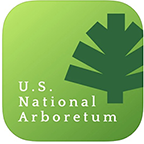
Google Play
Us national arboretum.
The National Arboretum’s official app includes a map of the grounds, information about the collections and plants, and self-guided tours.
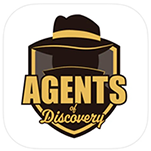
Agents of Discovery
Connect to nature and your community through augmented reality experiences in public spaces and use sensory skills to investigate the plants in the National Arboretum! Great for families.

iNaturalist
Identify plants, fungi, and wildlife with image recognition technology connected to databases by the National Geographic Society and the California Academy of Sciences.

Merlin Bird ID
Identify any bird you see with either a picture or answers to 5 simple questions. Learn everything about its diet, habitat, and songs.
An official website of the United States government
Official websites use .gov A .gov website belongs to an official government organization in the United States.
Secure .gov websites use HTTPS A lock ( Lock A locked padlock ) or https:// means you’ve safely connected to the .gov website. Share sensitive information only on official, secure websites.

U.S. DEPARTMENT OF AGRICULTURE
National arboretum: washington, dc.

Visiting the U.S. National Arboretum in Washington, DC
Discover a stunning collection of plants and instagram-worthy sights with our guide to the best things to see and do at this free outdoor museum..
What and where is the U.S. National Arboretum?
The U.S. National Arboretum is located at 3501 New York Avenue NE in Washington, DC. The grounds are open to the public from 8 a.m. to 5 p.m. every day of the year except Dec. 25. The Arboretum’s popular National Bonsai & Penjing Museum is open from 10 a.m. to 4 p.m. every day except for federal holidays that fall from November through February. Admission to the Arboretum and the museum is free of charge.
Established in 1927 by an act of Congress, the Arboretum aims to increase the aesthetic, environmental and economic importance of landscape and ornamental plants. The attraction does so through gardens and exhibits, long-term botanical research and conservation of resources. The gorgeous, 446-acre property makes for an inspiring and visually captivating visit at any time of the year.
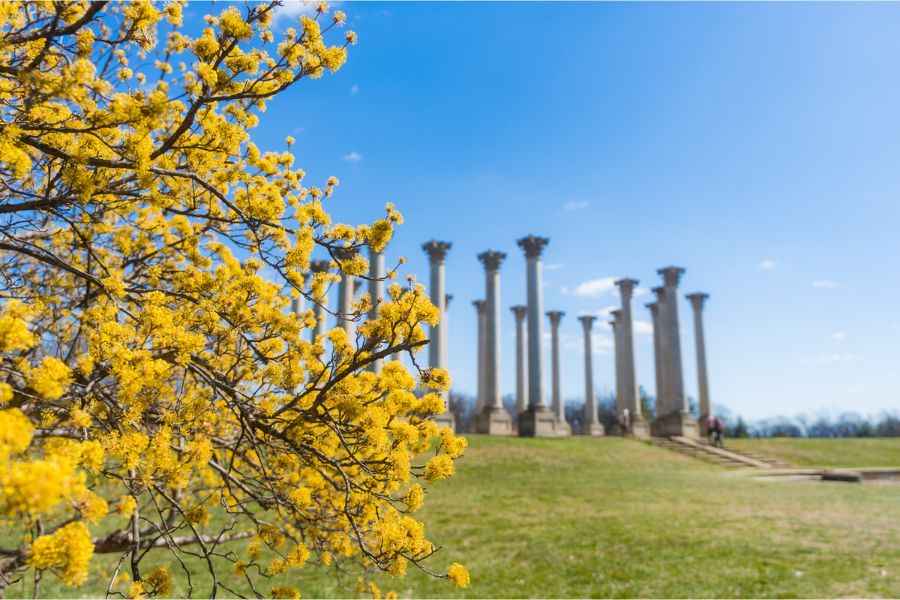
The easiest way to reach the National Arboretum is by car, as the grounds are located approximately 10 minutes from the U.S. Capitol Building. Parking is readily available, or you can use Uber or Lyft. Please note that the Arboretum’s R Street entrance is closed after 2 p.m. from Monday through Friday, so make sure to use the New York Avenue entrance if visiting at that time or later. Driving directions from numerous points in the DMV area are available on the Arboretum’s website .
If you choose to use Metrorail, exit at the Stadium Armory station on the Blue and Orange lines. Then, use the B-2 Metrobus and exit on Bladensburg Road. From there, walk two blocks to R Street, where you will make a right. Two blocks further, you’ll find the Arboretum gates.
What to see and do at the U.S. National Arboretum?
The Arboretum presents a stunning collection of plants, with each given its own display. One of the most popular is the Gotelli Conifer Collection , which showcases conifers that hail from a range of climates, including the Arctic and subtropical regions. Japanese maples, ornamental grasses and daffodils combine with the conifers to create an alluring array of colors. Make sure to stop in the gazebo, where you will have a full view of the Conifer Collection while resting.
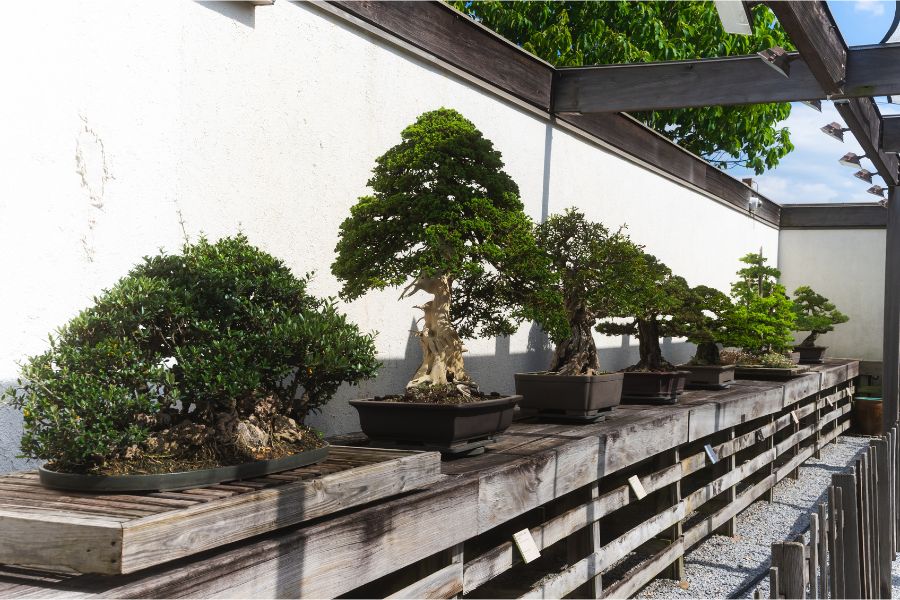
The aforementioned National Bonsai & Penjing Museum is another notable feature of the Arboretum. The museum is a riveting collection of legendary miniature Japanese and Chinese trees. The Japanese art of bonsai goes back more than one thousand years, a practice of growing beautiful trees in artful containers. The art of penjing is an even earlier version of the same practice, with both providing a calming effect on the observer. You’ll learn of this fascinating art and its conversation elements as you are dazzled by these living sculptures and natural scenes. The museum literally changes with the seasons, so it’s worth repeated visits.

No discussion of the Arboretum is complete without mentioning the National Capitol Columns . The permanent installation features 22 Corinthian columns that supported the east portico of the U.S. Capitol when it was built in 1828. Once the dome of the Capitol was completed in 1864, builders realized that the columns were not properly constructed to support the dome, creating an odd and unsettling visual. The strange aesthetic was not solved until 1958, and it took until the 1980s for the columns to find their resting place on the Ellipse Meadow in the Arboretum. Now, the site of the columns serves as one of the most beautiful (and Instagram-worthy) sights in the nation’s capital.
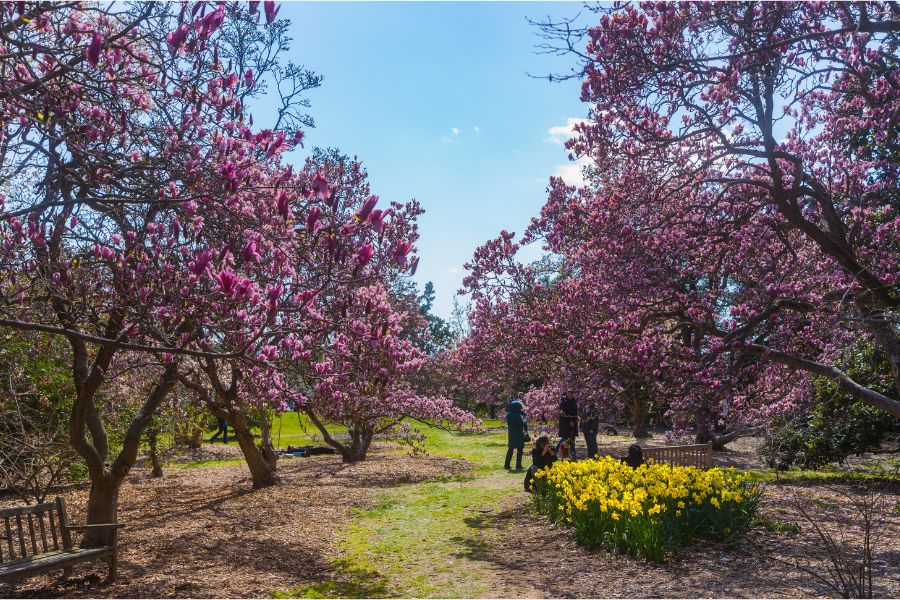
The U.S. National Arboretum also offers azalea blossoms, making it one of the best places to view blossoms in the District . The azalea blossoms usually peak at a different time than the blossoms found near the Tidal Basin, offering an additional opportunity to marvel at the beautiful trees and their scenic flowers. This arrangement of blossoms is located near the Capitol Column Overlook and the Flowering Tree Walk.
Finally, make sure to take note of the Arboretum’s events , which can include moonlight-adorned hikes and celebrations and educational programs.
More About DC
You may also like..
Things to Do This Week in Washington, DC
Where to Find the Most Colorful Street Murals in Washington, DC
Things to Do This Weekend in Washington, DC
National Arboretum in Washington, DC
:max_bytes(150000):strip_icc():format(webp)/Rachel-58092b055f9b58564c6639af.jpg)
Taylor McIntyre / TripSavvy
The National Arboretum in Washington, DC displays 446 acres of trees, shrubs and plants and is one of the largest arboretums in the country. Visitors enjoy a variety of exhibits from formal landscaped gardens to the Gotelli Dwarf and slow growing Conifer Collection. The National Arboretum is most known for its bonsai collection. Other special displays include seasonal exhibits, aquatic plants, and a National Herb garden. During the early spring, the site is a popular spot to see more than 70 varieties of cherry trees .
Getting There
There are two entrances: one at 3501 New York Avenue, NE, Washington, DC and the other at 24th & R Streets, NE, off of Bladensburg Road. There is plenty of free parking on-site. The closest Metro stop is Stadium Armory Station. It is a two-mile walk, so you should transfer to Metrobus B-2; disembark the bus on Bladensburg Road and walk 2 blocks to R Street. Make a right on R Street and continue 2 blocks to the Arboretum gates.
Public Tours
A 40-minute tram ride with a taped narrative highlights the history and mission of 446 acres of gardens, collections and natural areas. Tours are available on weekends and holidays and upon request. Scheduled times are 11:30 a.m., 1:00 p.m., 2:00 p.m., 3:00 p.m., and 4:00 p.m.
Visiting Tips
- Take the tour, it is the best way to see the grounds and learn about the gardens.
- Bring a picnic, which you may enjoy in the picnic area at the National Grove of State Trees.
- Check the schedule of events and attend a special program. See what's blooming, so you can plan ahead and be sure to see what's most interesting at the time of year that you are visiting.
- Be sure to see the Bonsai exhibit.
50 Best Free Things to Do in Washington, DC
A Visitor's Guide to the Smithsonian Museums in Washington DC
20 Best Things to Do in Washington, D.C.
The 26 Best Washington, D.C. Monuments and Memorials
12 Best Things to Do in Washington, DC, With Toddlers
Washington National Cathedral (Tours & Visiting Tips)
What to See and Do on the National Mall in Washington, D.C.
National Gallery of Art: Jazz in the Garden
Two Days in Washington DC: A 48 Hour Itinerary
How to Experience the Cherry Blossom Festival in Washington, DC
One Day Tour Itinerary in Washington, DC
15 Best Places to Go with Kids in the Washington, D.C. Area
Passport DC 2020 (Washington DC Embassy Open Houses)
May in the Capital Region: Weather, What to Pack, and What to See
The 15 Best Gardens in the Washington, D.C. Area
Arlington National Cemetery: What to See and Do
clock This article was published more than 3 years ago

How to make the most of the National Arboretum, from the redwood grove to the secret pavilion

The National Arboretum is a place full of contradictions. It was established by Congress in 1927 as part of the U.S. Agriculture Department “for purposes of research and education concerning tree and plant life.” Ninety-four years later, scientists still work in its greenhouses and open fields, while generations of Washingtonians have adopted it as a government-owned city park, a place to sit under trees with friends or take kids to ride bikes.
At 446 acres, it’s one of Washington’s largest green spaces, but it’s cut off from the city by multilane commuter routes on two sides, and the Anacostia River on another. It regularly turns up on listicles for “ D.C. hidden gems ,” but the National Capitol Columns , which featured on the East Portico of the Capitol from 1828 to 1958 and were placed in the arboretum in 1990, are included in just about every “ Most Instagrammable places in D.C. ” roundup online.
And yes, the columns are a wondrous thing: Evocative of the ruins of an ancient temple, placed in the wild Ellipse Meadow, they make such a stunning backdrop that the arboretum requires professional photographers to apply for permits , in the hopes of managing the endless engagement/graduation/fashion photo shoots. But there’s so much more to see at the arboretum than old sandstone.
With warm weather bringing the blooming of magnolias, dogwoods, cherries and azaleas, it seemed like a good time to go back to the great outdoors, and take a closer look at the arboretum. The facility itself remains affected by the coronavirus — the National Bonsai and Penjing Museum and the Washington Youth Garden remain closed, as does the bucolic Fern Valley , where the pathways are too narrow for social distancing — but we spoke to horticulturists, birders and the Friends of the National Arboretum to find out where we should be exploring right now, and in weeks ahead.
It turns out we were just in time: Visitor numbers have been booming in recent weeks, and if they keep climbing to the point where social distancing is difficult, the arboretum may begin to restrict the number of people allowed on the grounds, as it did last summer. Visiting before or after work, rather than on a weekend, remains the best advice, but there’s really no bad time to take advantage of this amazing resource.
In the heart of the city, Rock Creek Park offers places to picnic, play or just get away from it all
The Asian Collections
Occupying the easternmost edge of the arboretum, the Asian Collections fill a scenic landscape that slopes down toward the Anacostia River. Gravel paths and stone steps wind past valleys of shrubs and evergreens, leading to terraces with peaceful benches where you can pause and admire the views of flower-covered hillsides as well as the river. It’s one of the more romantic sections of the arboretum.
Different sections are named for the plants’ countries of origin — Japanese Woodland, Korean Hillside, China Valley — stitched together harmoniously as you navigate the trails, which can be twisting and steep. A highlight is a Chinese-style pagoda, which looks out over the Chinese and Asian valleys, and can also be busy with groups taking photos.
At the end of the trail closest to the parking lot is a glen of brightly colored camellias. Their beauty is a tribute to the arboretum’s scientific mission. Harsh winters in the 1970s killed 941 of the arboretum’s 956 camellia plants. A National Arboretum scientist named William Ackerman began breeding the hardy survivors with other camellias, seeking to find one that could survive this region’s cold temperatures, and ultimately created more than 50 new hybrids, including a number that still bloom here.
Cherry blossoms
Peak bloom for the Tidal Basin’s cherry blossoms arrived earlier this week, and with any luck, they might stick around for seven to 10 days after that, depending on conditions. But at the arboretum, home to more than 70 varieties of cherry tree, some ornamental cherries flowered more than a week before the blossoms downtown, and others have yet to reach their peak.
Cherry blossoms are planted in multiple areas throughout the arboretum, sometimes alongside other flowering Japanese fruit trees. Beyond keeping an eye out for white, coral or rose-colored petals as you stroll through the grounds, take a look at the self-guided cherry blossom tour on the arboretum app (see below). The research fields on Valley Road, near the parking lot, are home to a sun-dappled grove of trees collected in Japan, experimental hybrids, and trees used for breeding and preservation purposes.
Want to see beautiful, pink cherry blossoms? Head to the National Arboretum, not the Tidal Basin.
Crape myrtle nursery and Research Nursery 6
If there’s an area that demonstrates how easy it is to miss some amazing plants at the arboretum, it might be these adjacent research fields, located between Meadow Road and Valley Road. “It’s a very, very beautiful spot,” says botanist Kevin Conrad, the curator of the arboretum’s Woody Plant Landscape Germplasm Repository. “To sit underneath some of those incredibly old and stunningly beautiful crape myrtles is really a horticultural experience. It’s a plant that is exquisite from many perspectives.”
You might think you’ve seen a few crape myrtles in your neighborhood. They’re not like this example of Lagerstroemia fauriei , which the arboretum has given the accession number 10536-P. “This tree is an original from the John Creech expedition in Japan to the ’50s, where he collected this tree and brought it back,” and used it in the creation of numerous hybrids resistant to powdery mildew, such as Natchez and Arapaho. It’s not labeled, Conrad says, but it’s hard to miss: “The tree is 30 feet tall by 30 feet wide, with a trunk that’s got to be two feet in diameter. The bark is dark, with brown and blackish mottling throughout. It’s incredible.”
Nearby, close to Meadow Road, there’s another outstanding specimen that was growing here before the establishment of the arboretum: a willow oak “that, they’re saying, is almost 150 years old, with a five-foot-diameter trunk. To sit under it is amazing — or to give it a hug,” he says. This tree is in the Arboretum’s collection as 79411-H. To find their locations, plug their accession numbers into the arboretum’s interactive map, at usna.usda.gov/abe .
The dawn redwoods
Across from the entrance to the Gotelli Conifer Collection , clustered on a triangle-shaped island between two roads, is a stand of tall, skinny trees with flared bases and knobby roots. They exude age and nobility. You have to crane your neck to see the crowns.
These are dawn redwoods, which fossil records tell us grew across Europe and North America millions of years ago. But then they became extinct — or so biologists once thought. In the 1940s, a researcher in Central China’s Hubei province began examining some unusual old trees, and in 1946, Chinese botanists announced that the genus Metasequoia had been rediscovered.
Seeds made their way around the world, including to the arboretum, which acquired its seeds in May 1948. “Just stand there and enjoy the moment, because you’re in a grove of trees that were thought to be extinct,” says Conrad. “The grandeur of them, the buttressed trunks, the fact that they’re in a grove really makes it a magical place.”
The Dogwood Collections
Cathy Kerkam, the director of fundraising and communications for the nonprofit Friends of the National Arboretum, knows what to do when she needs to take a break: She heads for the Dogwood Collections , perched in the upper northeast corner of the grounds, far from the popular areas. “When the dogwoods come out and they’re in full bloom, there’s every color you can imagine,” she says. “It’s just a fairy tale back there.”
But now, before the dogwoods blossom, might be the best time of all. “There is a little secret pavilion in the woods, called the Anacostia Overlook,” Kerkam says. “You can sit in that little pavilion and you’re up on a precipice looking down over the Anacostia River. And sometimes you can see the eagles hunting.” It’s not that you should ignore the flowering trees, and the long, grassy allee that leads from the entrance down to an ornamental fountain. But this tranquil perch, overlooking a bend in the river, is worth seeking out.
Gotelli Conifer Collection
On the occasions when you think about conifers, Christmas trees are probably the first things that come to mind, or possibly a scenic pine forest with a needle-strewn floor. The Gotelli Conifer Collection is proof of just how much more is out there: Shortly after wandering into the conifer area, you’re staring at a stunning seafoam-green atlas cedar that resembles a spiky mop of a weeping willow, a dwarf blue spruce the size and shape of a small boulder, and trees whose needles are icy blue, sunset gold or electric lime green. The contrasts in shape, texture and color are most striking when you can take a step back to compare, so take a moment to pause in an attractive hillside pagoda or at one of the wooden benches along the grassy paths.
William Gotelli, a private collector who assembled 1,500 conifers for his New Jersey home, donated his treasures to the arboretum in 1962. What makes this section so enjoyable to browse is the layout, with the conifers arrayed in gravel or rock-lined beds, along with a mix of ground cover, flowers and smaller shrubs. Row after row of evergreens might blur together. This arrangement gives plants space to breathe, and lets the trees and shrubs shine, in all their hues.
The Morrison Garden
Azaleas have flowered on the slopes of Mount Hamilton, the highest point on the arboretum grounds, since the late 1940s, thanks to Benjamin Y. Morrison, the first director of the arboretum. Morrison was devoted to the idea of breeding large, colorful hybrid azaleas that could survive Mid-Atlantic winters. The wide variations in colors and shapes, far different from the azaleas on display in most suburban yards, draw crowds of azalea lovers to the trails of Mount Hamilton during the blooming season, which begins in late April and early May.
But year-round, there’s a calm to be found in the Morrison Garden , a brick-walled formal garden at the base of the mountain. Rows of Morrison’s hybrid Glenn Dale azaleas , named for the Maryland town where Morrison did much of his research at a USDA facility, feature vivid colors and unusual stripes, providing a startling contrast to boxwood hedges and a shaded brick path leading to a large, ornate pottery planter. A solitary bench under a trellis provides a view up the mountain, which rises to 240 feet above sea level, and pops of color from the floral plantings there. On the way out, take notice of the Chinese lace-bark pine tree, whose exquisite bark is mottled with abstract silver, white and gray blotches as engaging as an impressionist painting.
The gardener’s guide to azaleas
Springhouse Run
For a glimpse of the arboretum’s past, and how land can be transformed, there’s no better area than the stretch of water called Springhouse Run. Beginning in the early 20th century, this section of the grounds, stretching south from Route 50 and the arboretum gates, was home to bottled water operation — two conical brick “springhouses” that give the creek its name are still visible — and a brick manufacturing facility, which closed in the 1970s but left the round kilns that can be seen from New York Avenue NE.
Over the years, the stream — which flows into the larger Hickey Run, and then the Anacostia — was diverted from its path into a concrete channel, and became polluted and choked with invasive species. An extensive restoration created a more natural route for the water, flowing through pools and over small waterfalls, creating a habitat for native plants and wildlife, including birds.
“For me, and many birders I know who go [to the arboretum], the current go-to spot is the stream restoration area,” says Paul Pisano, who leads bird walks at the arboretum for the Audubon Naturalist Society . The revamped landscape “has really paid off for the birds. Lots of food and cover, plus a steady source of water.”
A rare lark sparrow was seen here in the winter of 2017-2018, just after the restoration, but Pisano says the area has been a good place to see finches, a house wren and Lincoln’s sparrow. For the best results, wander north from the fields near Meadow Road and Valley Road, toward the pond near Hickey Lane. Pisano also notes that birding is best in the early morning, so he suggests birders arrive as close as possible to the arboretum’s 8 a.m. opening.
A flying start: How to start birdwatching
Self-guided tours
Before you head to the arboretum, download the free U.S. National Arboretum app to your smartphone.
The whole premise sounds contradictory: You’re going to the arboretum to enjoy natural beauty and be present in nature. You’re not there to spend even more time staring at a screen, trying to ignore email and Slack notifications. But using the arboretum app guarantees a deeper appreciation and more enjoyable experience.
Zoom in on an interactive topographic map of the grounds to learn the name of the curious-looking tree or flowering plant next to you, and where and when it was collected. The Here/Now tab provides news about what species are flowering this season — camellias! daffodils! — and where to find them. Some of the information is outdated because of the pandemic. (For instance, it refers to the bonsai museum and Visitor Center as open.)
Self-guided tours, though, are the reason to keep firing up the app, offering more insight beyond the interpretive signs around the arboretum or the free visitors guide brochure available throughout the grounds. First-time visitors can start with the Arboretum Overview, which visits most corners of the park; for a more narrow focus, there are tours looking at the lavender or chile pepper plants within the National Herb Garden . A popular one this time of year stops at more than two dozen varieties of cherry blossom trees along a 3.2 mile path, showing off a clone of a Yoshino tree planted at the Tidal Basin by first lady Helen Taft in 1912, or inviting visitors to see experimental trees in the Research Fields. The format allows you to explore at your own pace: If you don’t have time to see everything, you can pick your own highlights, or save some for the next visit.
Of course, the tours don’t have to be educational: Those who want to take advantage of the fresh air can fire up running and walking courses that pass by arboretum highlights along loops ranging from 1 to almost 5 miles.
The essentials
Update : On April 5, 2021, the National Arboretum announced that was limiting the number of cars allowed on the grounds, and that the R Street NE gate would close to cars.
The National Arboretum is open from 8 a.m. to 5 p.m. every day except Christmas. Admission is free. Car access is now restricted to the gate at 3501 New York Avenue NE, a gate that is reached from an eastbound service road near the intersection with Bladensburg Road NE. Pedestrians and cyclists can still access the grounds through the gate at 2400 R Street NE.
The parking lots near the gate fill quickly on weekends. The Friends of the National Arboretum recommend using the parking lot near the Grove of State Trees and picnic area, on the south side of the grounds. From there, it’s an easy walk to the Capitol Columns and other collections mentioned above. Also, while there are smaller parking lots near some collections, such as the Asian Collections or the conifers, these lots usually have room for only 10 to 12 cars. At peak times, it’s easier to park and walk than to drive from site to site.
Because of federal regulations, visitors must wear masks and maintain social distance at all times.
Restrooms and soda and water vending machines are located in Arbor House, near the R Street Gate and parking lot. Additional restrooms can be found near the National Grove of State Trees and at the parking lot between the Asian and Dogwood collections.
A new, younger ‘First Lady’ bald eagle moves in at the National Arboretum
How the National Arboretum got its ferns and became a civic treasure
National Arboretum revives an innovative garden that ran out of steam

Visit Washington, DC!
Hotel and travel tips for visiting Washington, DC
National Arboretum
Think flowers, think Washington and you’re likely to think of the gentility and romance of the cherry blossoms softly blowing in the early spring breezes alongside the Tidal Basin near the Jefferson Memorial. As great an early April sight and memory that might be, here’s a memory in the making that many Washington, DC, residents are not even aware of — a vast collection of blooming flowers that can be seen year-round for free.
That memory takes shape with a visit to the U.S. National Arboretum, a short drive from the D.C. monuments that tourists usually think of when they plan on visiting Washington, D.C.
The Agricultural Research Service, an arm of the Department of Agriculture, opened the facility along New York Avenue NE (Rte. 50) more than eight decades ago for floral and landscape research and to solve agricultural problems to benefit the nation’s food supply. Plant research and educational projects still take place at the Arboretum, but Washington., D.C. tourists most likely will want to bask in the quiet of the gently rolling lands at the Arboretum and commune with nature as they glimpse at the astounding array of seasonal colors and blooms. There are also plenty of meadow-like grassy areas for kids to run off some energy. By all means take a picnic basket if you like.
Yes, there are cherry blossoms here, too, in early spring, but visit three, four weeks later, in late April-early May, and you can ooh and aah at the astonishing sight of 15,000 azaleas cascading on the hillsides of Mount Hamilton. Brilliant shades of pinks and reds and lavenders mix with the white azaleas. Hundreds of white-flowered dogwood trees provide the canopy for the azaleas, but don’t miss the nearby crabapple, peony and rose blooms as well.
Spring may be the Arboretum at its showiest, but the other seasons provide a palette of colors as well. Visit in the summer and capture the warm-weather magic of day lilies and water-lily flowers in the ponds adjoining the arboretum’s headquarters building as well as a Washington specialty, the pink and magenta hues of crapemrytle trees.
Capture the magic of the vibrant yellows of tulip poplar trees in the fall along with the bright red leaves on black gum trees and the purplish reds of the sweet gums and dogwoods. Washington winters are not generally harsh, although a snowstorm or two is a capital staple. You can catch shining red berries on holly trees at the Arboretum and the waxy green leaves of the Southern magnolias provide a holiday accent, and a stark contrast to the occasional snow. By February and early March visitors can spot the first signs of spring: blooms from camellias, winter jasmine, Japanese apricots and other harbingers of warmer days ahead.
Aside from the seasonal showcase that the Arboretum provides, don’t miss the permanent collection of tiny trees at the facility’s National Bonsai & Penjing Museum. Some of these specimens of horticultural art at its finest date back four centuries, 150 years or so before the nation’s birth. The miniature potted plants have a prehistoric look, shaped and sculpted in a manner that fosters quiet contemplation only minutes from the bustle of the monumental core of a D.C. visit.
And one final note for your Arboretum visit, for kids of all ages. Get a spare quarter out of your pocket and buy a handful of goldfish food to feed the hungry hundreds in the ponds. The yellow and orange fish, some small, some much larger, swarm to the edge of the ponds when tourists toss a few pellets into the water. And don’t worry about over-feeding them because when the small vending machine with the pellets is emptied for the day, the fish have to wait for more until the next day.
Travel Tips
Want to tour the Arboretum? Nine miles of roadways connect the gardens and collections for those touring in a car, bus, or bicycle. Small parking lots are situated at each of the stops. If you can, take your bike instead of driving to avoid the crowded parking lots. Those wishing to go by foot can visit the Aquatic Garden and Koi Pond surrounding the Administration Building, the Friendship Garden, the National Herb Garden, and the National Bonsai & Penjing Museum, four easily accessible areas. Serious hikers are welcome to venture out into other trails of the Arboretum. Lastly, a tram is available for touring the grounds. Check the website for more information at www.usna.usda.gov/Information/tram.html .
There are not many eating options at the Arboretum (the food cart with lunch options is only out some weekends and holidays; otherwise, there are only snacks at the gift shop), so a picnic is usually the way to go. Picnics are allowed on the east terrace or at the picnic area at the National Grove of State Trees, but nowhere else.
For more information on the United States National Arboretum, visit www.usna.usda.gov/index.html .
Leave a Reply Cancel reply
Your email address will not be published. Required fields are marked *
This site uses Akismet to reduce spam. Learn how your comment data is processed .
- Washington DC
- Things to Do
- Restaurants
- Vacation Rentals
- Travel Stories
- Rental Cars
- Add a Place
- Travel Forum
- Travelers' Choice
- Help Center
Well worth the visit - U.S. National Arboretum
- United States
- District of Columbia (DC)
- Washington DC
- Washington DC - Things to Do
- U.S. National Arboretum
Well worth the visit
Visited the National Arboretum in D.C. today. Nearly a hundred thousand commuters drive on New York Avenue heading in and out of downtown DC but few realize they passing on the capital's major parks and even fewer ever visit it. This is a shame because the gardens of the park are one of the city's treasures. It was a late fall day, the leaves were off many of the trees and only a few plants were in bloom, yet there was still a grand diversity of native, exotic, and cultivated plants to admire in their year-end regalia. We wandered through the Azalea Gardens, the aptly named Fern Valley, and then the Asian Collection overlooking the Anacostia River. This last area still had a dazzling display of plants in bloom as well as lots of color in the foliage; it also seemed to be the favorite of flocks of blue jays and cardinals. And we didn't visit half the areas of the park. On the way back, visited the Bonsai & Penjing Museum which houses the largest collection of bonsai trees - many in training for decades - that I have yet seen. Could have spent hours in these pavilions alone. Can't wait to go back and visit the Arboretum again in the spring.

It's not at the mall, nor does it have crowds. This place is beautiful. bring a lunch and stay all day. You can find history here too. Plants, Plants, and more plants. Walking, hiking, over sculptured acres of land, special exhibits too. Japanese gardens, you name it folks, it;s got it. A must for outdoors lovers. Don't miss this. On weekends there is a $4 tram tour through the gardens. AAA+
I really enjoyed my day at the National Arboretum. I went during the end of April when the Azaleas were blooming, which was nice. They Azalea collection is on a wooded hill which you can see by walking on the trails. It was neat to see them in full bloom, azaleas of every color. Besides the Azaleas there is a lot to see at the National Arboretum. There is a small visitor center which is a good place to start, there are maps and guides for each of the gardens in the Arboretum. From the visitor center you can walk to the Bonsai Museum which is pretty much worth the trip itself, These trees are amazing to see up close, how perfectly maintained they are. Across the street is the herb garden, which is pretty, and you can get a good view of the Capitol Columns. The Columns are also only a short walk from the visitor center, which are worth checking out. I think everyone would enjoy the Arboretum. I would not consider it a must see it you are visiting DC for the first time, but if you have seen most of the major attractions and looking for something else to do, it is worth checking out, and its free!

My family was visiting from Canada and after spending the previous day in the city with all the crowds, the arboretum was exactly what they needed. We arrived early and spent the morning in the bonsai museum, ate our picnic lunch that we brought with us and then spent the afternoon walking through the dogwood and Asian collections. It was a wonderful day, great weather for walking and we all really enjoyed ourselves.

This place is fantastic for a relaxing bike ride or for a good exercise as there's lots of hilly terrain. We rented two bikes from "Better Bikes Inc." who delivered them to the Arboretum and picked them up later the same day. Ken, who runs Better Bikes, is awesome. He's very accomadating to whatever the customer requests and he even gave us a ride to the metro at the end of the day. This place is great place for pictures, a picnic, relaxation, exercise or peace and quiet.
What a marvelous retreat from the frenetic crowds that visit DC's museums! A lesser-known and considerably less crowded attraction, the National Arboretum is beautiful. Even by mid-day on a weekend, the research "museum" is hardly crowded. The grounds are divided into various sections and each section has its own trail network. Not only is the National Arboretum peaceful, but it's also educational. Nearly every plant is labeled and there are informational plaques all over the place. I never knew allspice was related to the citrus family! From the general landscaping to the flowers in bloom, the arboretum is also a photographer's paradise. If you're looking for something other than the Smithsonian museums, be sure to check out the National Arboretum. You won't be disappointed.

Welcome to the U.S. National Arboretum
General information.
The grounds of the U.S. National Arboretum are open from 8 a.m. to 5 p.m. every day of the year except for Christmas Day. The National Bonsai & Penjing Museum is open 10 a.m. to 4 p.m. daily except for federal holidays from November through February. Admission to the grounds and museum is free and no tickets are needed.
NEW SPRING 2024 TRAFFIC PLAN IN EFFECT
Beginning Wednesday, March 27 through mid-May, the Arboretum will implement a temporary traffic plan that impacts traffic flow and parking throughout the grounds. CLICK HERE for details.
Explore beyond the Tidal Basin!
The Washington Post’s verdict is in: the Arboretum is the place to see flowering cherries this spring! Explore the collection with our self-guided tour.
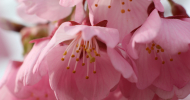
Interactive Map
Looking for a plant? Try our interactive map and living plant database search, and plant browser, the Arboretum Botanical Explorer (ABE), designed for large-screened devices.
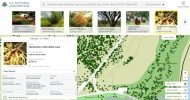
Subscribe to the newsletter!
FONA Field Notes is the free weekly newsletter of the Friends of the National Arboretum. Sign up to stay in the know about everything happening at the Arboretum!
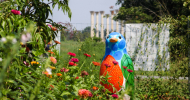
Proposed Canopy Trail
The USNA has prepared an Environmental Assessment (EA) to analyze the potential impacts associated with the proposed construction and operation of a canopy trail attraction.
Explore Flowering Cherries Beyond the Tidal Basin
Beyond the Tidal Basin explores the remarkable beauty of ornamental cherry trees as well as the National Arboretum’s long history with them. This self-guided tour visits 40 sites spread out across 450 acres. Each tree is marked...
The U.S. Department of Agriculture, Agricultural Research Service, U.S. National Arboretum (USNA) has prepared an Environmental Assessment (EA) to analyze the potential impacts associated with the proposed construction and operation...
Seasonal Traffic Pattern Changes in Spring 2024
Beginning Wednesday, March 27th through mid-May, the Arboretum will implement a temporary traffic plan that impacts traffic flow and parking throughout the grounds. We urge visitors to plan their weekend visit as early in the day as...
- Main Content
Share this page
Search search.
Enter keywords below.
Suggested Search Terms
- Of the Earth
- Children's Garden
- Spring Bloom Report
- Education Classes
- Plant Clinic
- Chicago Region Tree Census
- Weddings and Receptions
Explore Your Way Explore Your Way
Endless adventures await you this spring at The Morton Arboretum.
- Reserve tickets
Explore Your Way
There are so many ways to spend the day at the Arboretum—how will you spend yours?
Whether you’re looking for a peaceful walk or a place to picnic, frolicking with your kids in the Children’s Garden, strolling through the colorful blooms on display in the gardens and woodlands, or joining an adult education class with one of our expert educators, there is so much to enjoy this season at the Arboretum!
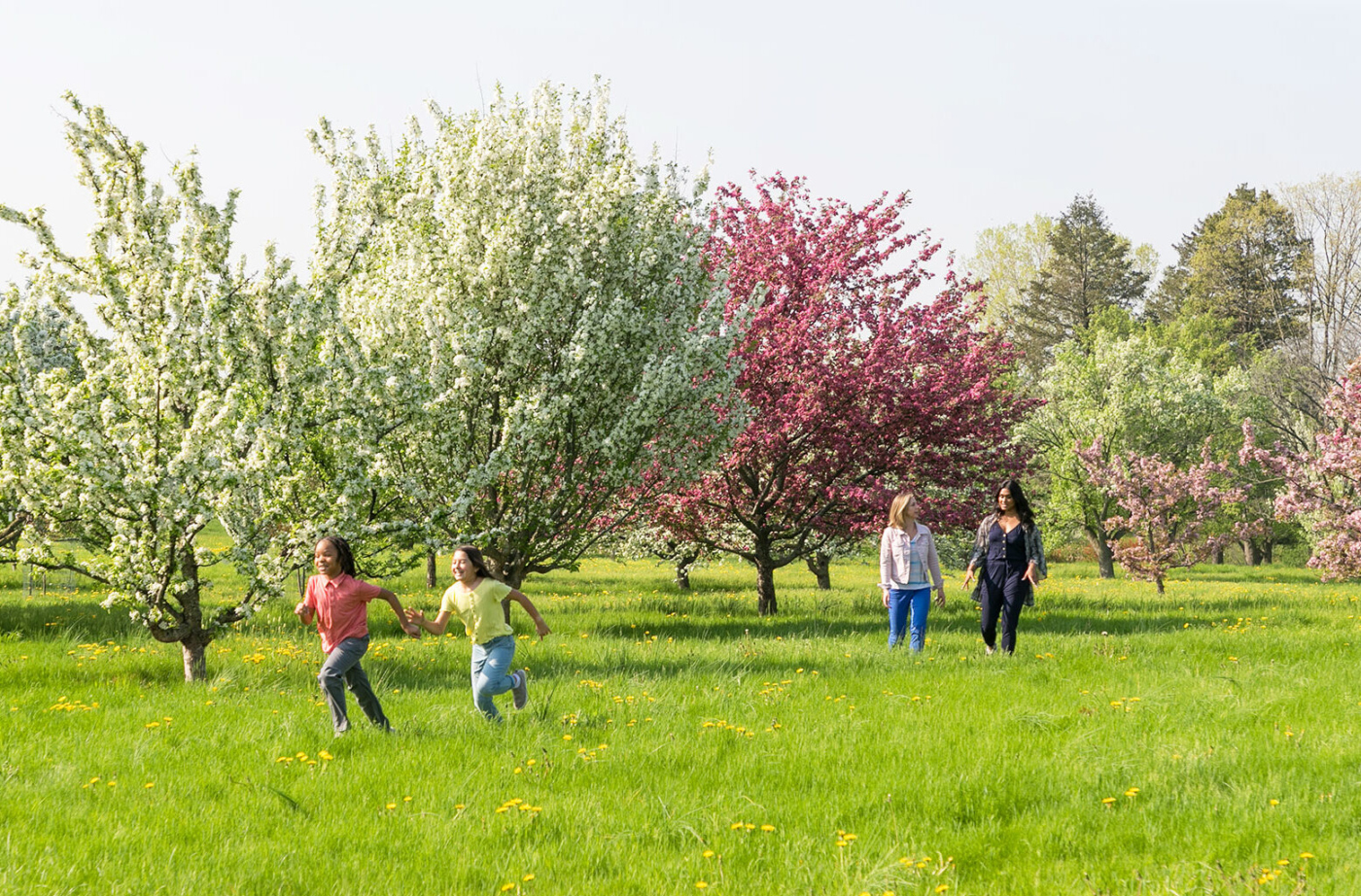
Children’s Garden
Watch your child explore the wonders of nature in the safe, kid-friendly, immersive environment of the Children's Garden, designed for children of all ages and abilities. Splash through secret streams, climb colossal acorns, and slide down giant tree roots all day long. With its picnic area, accessible design, and hands-on learning, you can easily make a day of it and never get bored!
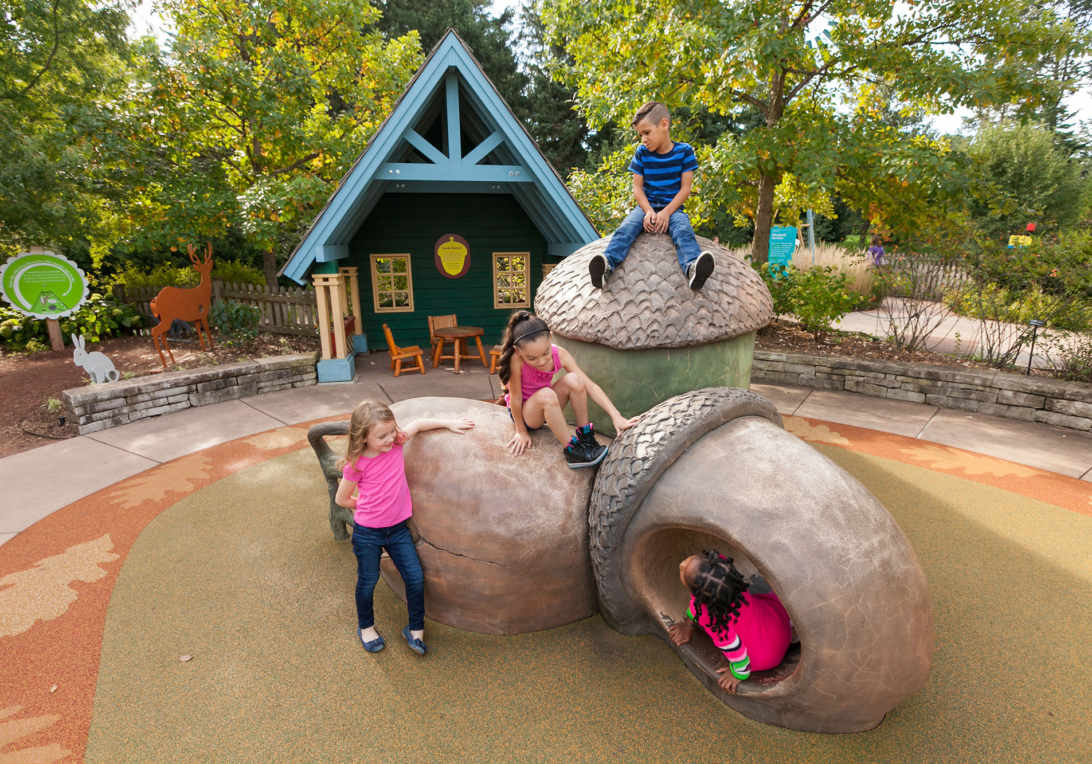
Spring Blooms
Find inspiration and delight in the colorful spring blooms at one of the many display gardens at The Morton Arboretum. The recently unveiled Gerard T. Donnelly Grand Garden serves as a centerpiece for the Arboretum’s East Side, and showcases spring blooms in the Joy of Plants Garden.
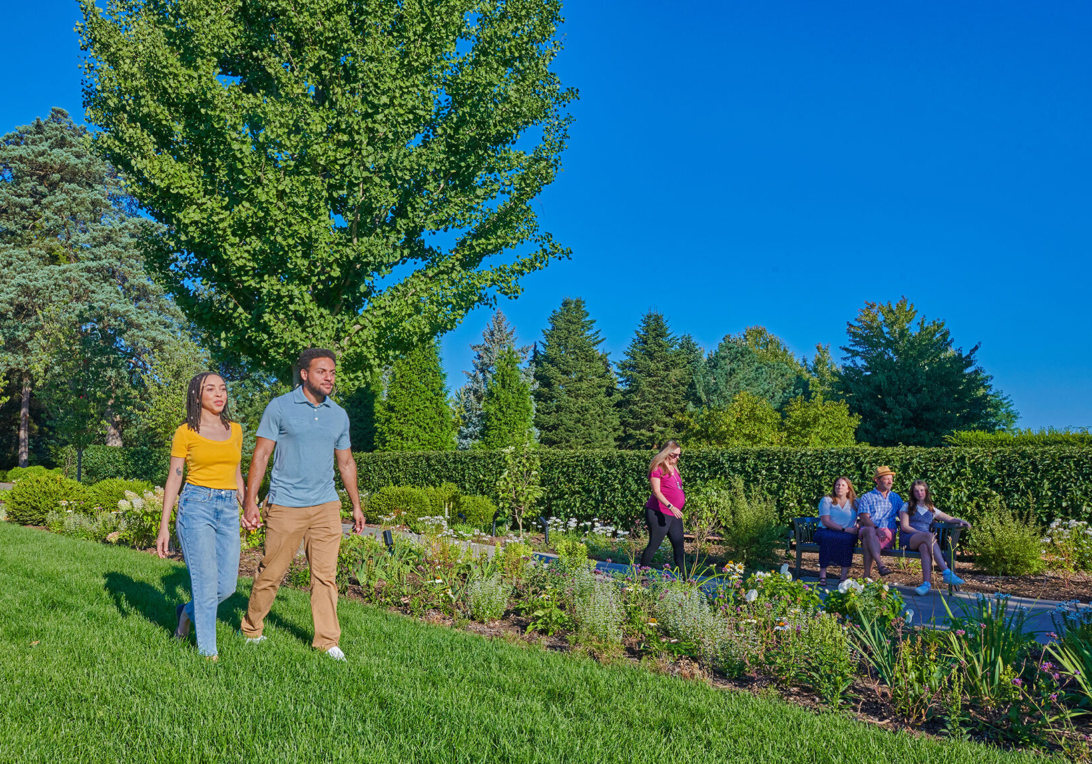
Explore the Grounds
Discover the unique landscapes and ecosystems found in the 1,700 acre grounds of the Arboretum. You can bring bikes, hike, take a guided tram tour, or drive along the paved roadways to see the magnificent natural areas of the Arboretum.
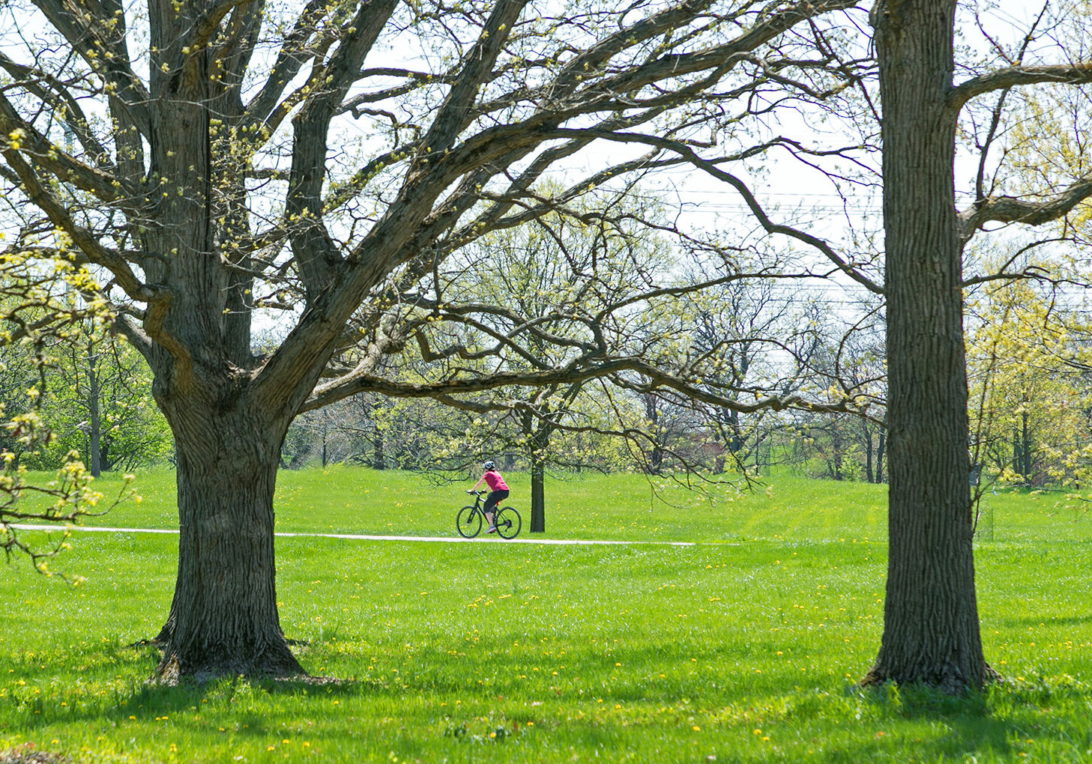
Find Tranquility
Within the Arboretum’s tree collections and trails, there are many opportunities to find a quiet spot to read a favorite book, connect with loved ones, or sit in peaceful reflection.
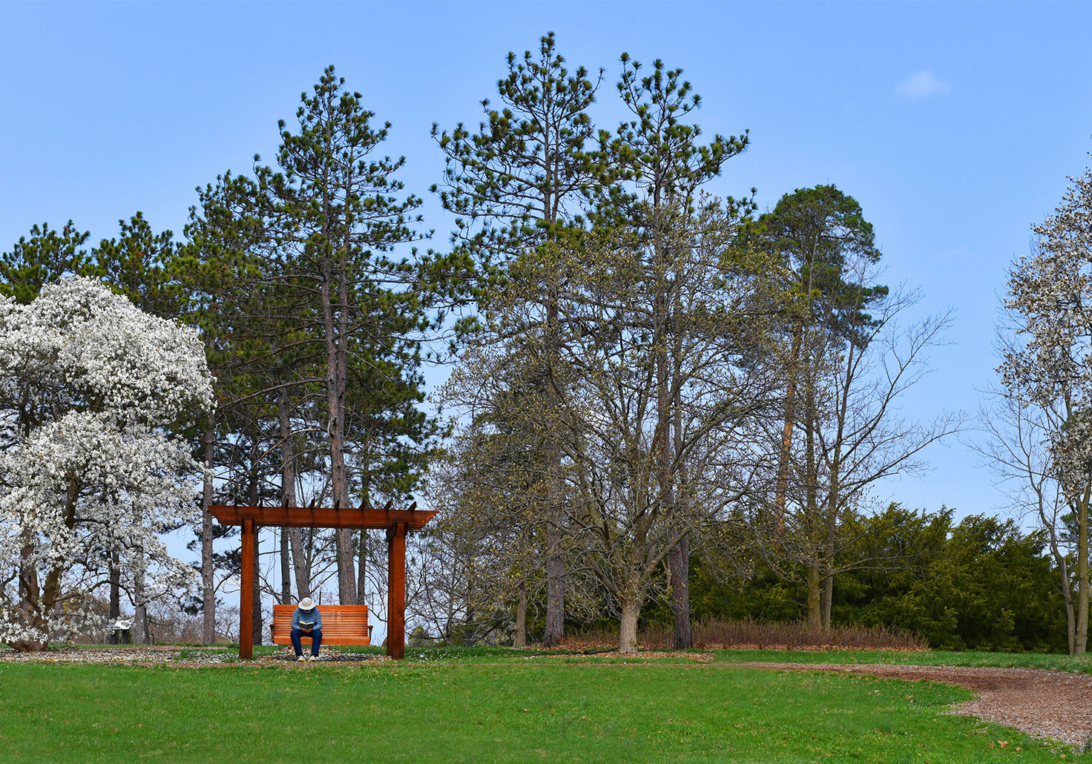
Featured Links
Know before you go, parking and directions, dine and shop, maps and guides, visiting with children.
Family members of all ages can connect and experience a fun-filled visit surrounded by trees and nature.
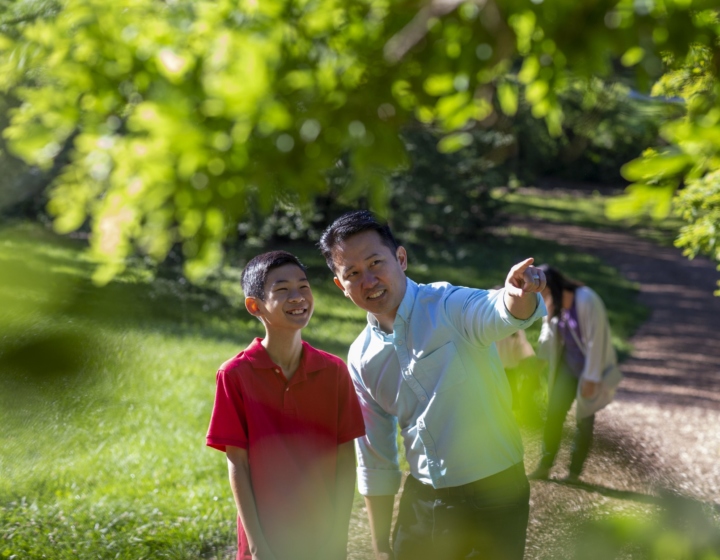
Accessibility at The Morton Arboretum
The Morton Arboretum welcomes guests of all abilities and strives to create a safe, enjoyable, and engaging experience for all.
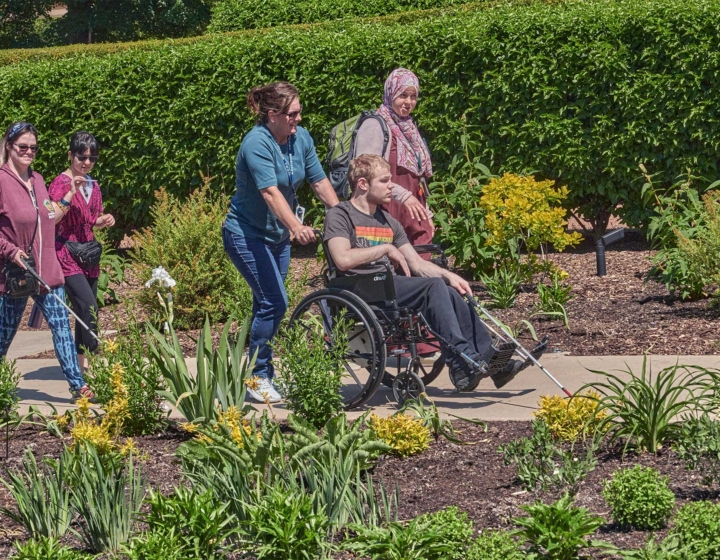
Hiking Guide
Immerse yourself in 16 miles of walking paths and hiking trails through the Arboretum’s woodlands, prairie, and gardens.
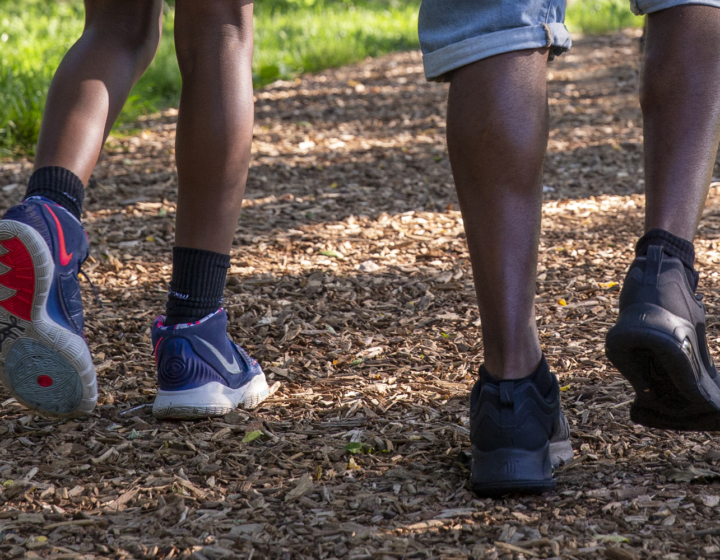
Art Exhibition
Explore the large-scale sculptural exhibition, Of the Earth
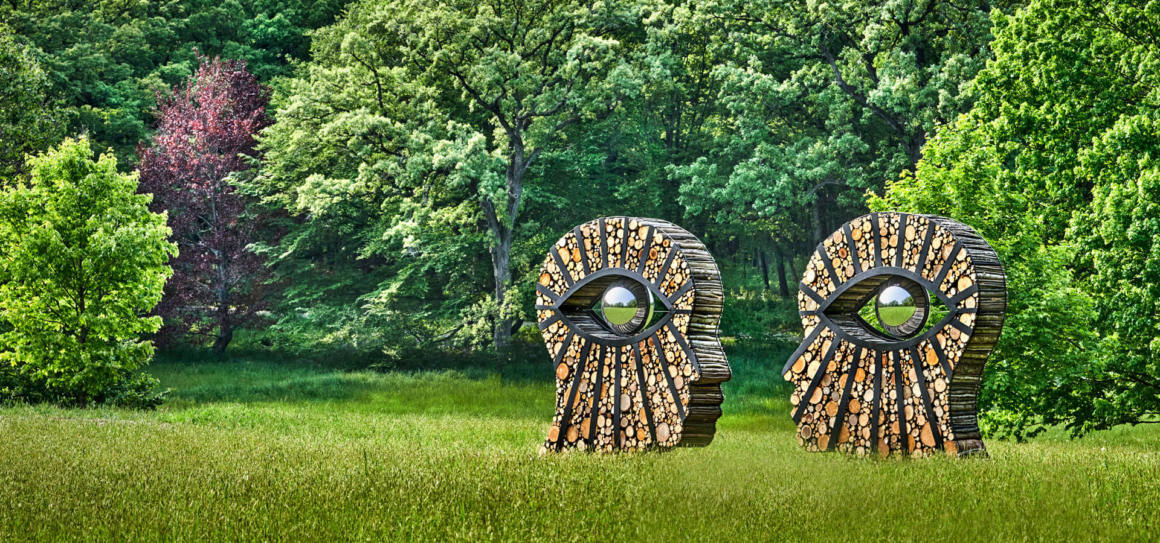
Frequently asked questions
Looking for more answers? Visit the FAQ or contact us directly.
Yes, group rates can be offered on orders of 15 or more people purchasing tickets in a single transaction. Purchasing Group Admission allows access to a discounted rate and makes check-in at the gatehouse easier than with General Admission. Group Admission can also be planned, purchased, and reserved further out than General Admission is available, allowing groups the opportunity to finalize their plans well ahead of time.
Manual wheelchairs are available for loan. Strollers are currently unavailable. Personal strollers are welcome.
Guests and members may stay and explore the Arboretum until closing at sunset.
For assistance, please email the ticket line at [email protected] and we will respond to you as soon as possible.
Explore More
Group visits.
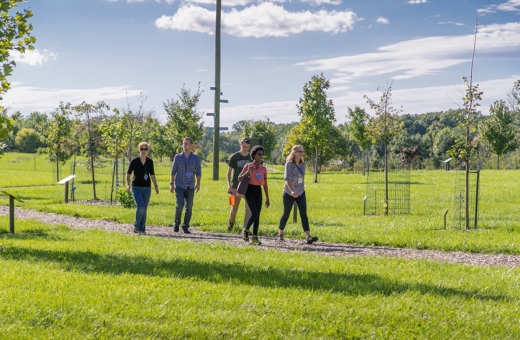
Learning Opportunities
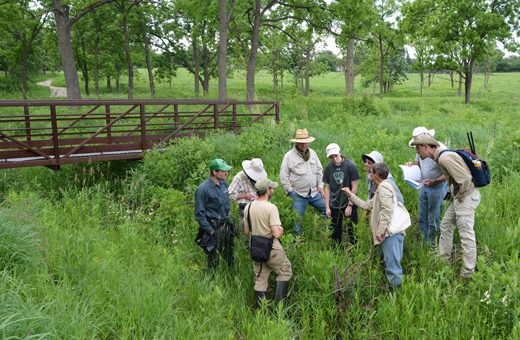
Tree and Plant Advice
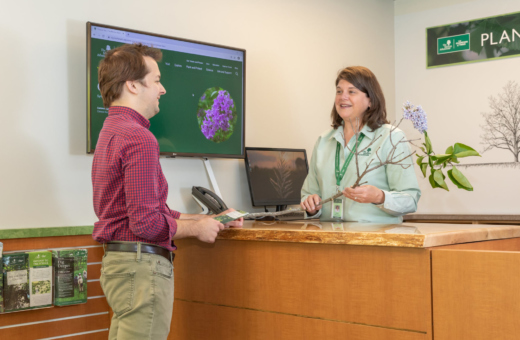
Special Events

Popup Gallery
- Washington Park Arboretum
- Getting Here
- Accessibility
- Maps & Trails
- Venue Rentals
- Graham Visitors Center
- Seasonal Highlights
Walking Tours
- Adult Education
- Youth Programs
- Birding & Boating
- Event Calendar
- Pacific Connections Garden
- Joseph A. Witt Winter Garden
- Woodland Garden
- Shoreline & Foster Island
- Rhododendron Glen
- Japanese Garden
- Core Collections
- Collections Database
- Interactive Map
- Plant Profiles
- Center for Urban Horticulture
- Elisabeth C. Miller Library
- Otis Douglas Hyde Herbarium
- Union Bay Natural Area
- Yesler Swamp
- Soest Herbaceous Display Garden
- Seattle Garden Club Fragrance Garden
- McVay Courtyard
- Goodfellow Grove
- Botanic Gardens at Home
- Regional Plant Sales & Garden Tours
- Ask a Gardening Question
- Plant Identification
- Search For Books
- 2022 Speaker Series
- Classes & Workshops
- Professional Continuing Education
- Conferences & Symposia
- Registration
- Exploration Kits
- School Field Trips
- UW Botanic Gardens Summer Camp
- Family Nature Classes
- Fiddleheads Forest School
- Self-Guided Adventures
- Park in the Dark
- Science & Conservation
- Washington Rare Plant Care and Conservation
- Faculty & Research
- Theses & Student Projects
- Restoration Ecology Network
- Academic Conferences
- Research Tools
- Collections
- Email Signup Form
- History & Planning
- College Home
- Directories
- Make a Gift
University of Washington Botanic Gardens
- University of Washington
Take the Arboretum TRAM TOUR and visit six continents in one hour!

This fully narrated 1-hour tour guides you through Seattle’s outdoor living museum:
- Learn about plants from nearly 100 countries.
- Discover the Arboretum’s connection with horses.
- Sample a 16th-century beverage made from the root of a woody plant.
PRIVATE 1-HOUR TRAM TOURS $220 plus tax (10-person max)
2024 SCHEDULE
We are currently closed for public tram tours. Private tram tours are available April through September
Do I have to purchase tickets in advance? Yes! For private tram tours we need to ensure we have a tour guide available for you. Our 1-hour tour times are generally 11 to 12 and 12:30 to 1:30.
What about inclement weather? Tours will run rain or shine. We ask that you check the weather forecast and dress accordingly if inclement weather is predicted. In cases of high winds, snow, or impassable roadways, you will be notified in advance and refunded accordingly.
Are there bathrooms along the way? No. Public restrooms are available at the beginning of the tour in the Graham Visitors Center.
Will locals enjoy the tour as well, or is it mostly for tourists? Absolutely! While you may be familiar with the Arboretum you will also have the opportunity to discover new things about Seattle! Additionally, this tour is an excellent way to entertain out-of-town guests.
Are tickets refundable? All ticket sales are final. If there are extenuating circumstances please contact [email protected] , but please note this is answered Monday through Friday between 9am and 5pm
Is the tour suitable for children? Including children is up to the discretion of the adults accompanying the children. Content is directed to adults, however.
Is the tour wheelchair and stroller accessible? Unfortunately, no. The tram does not have room for a wheelchair or stroller. If you are able to leave them in the Visitors Center and are able to sit on the Tram then yes, you can tour! Note: All mobility-impaired tram passengers must be able to climb aboard on their own, or with assistance from a professional caregiver that comes with them on the Tour. A UWBG step stool is provided, but no physical assistance will be given from Tour staff.
Where does the Tour depart? Washington Park Arboretum, 2300 Arboretum Drive East, Seattle, WA 98122. Check-in at the information desk located in the Graham Visitors Center anytime after 10AM. Tours will begin boarding about 5 minutes before departure.
Is there public parking available nearby? There are multiple parking lots for free near the Visitors Center. On a busy day these can fill early! We also recommend taking public transportation and/or using resources such as Uber, Lyft, or bike-share programs. We are about a 20-minute walk from the UW Light Rail Station. Specific parking and public transportation directions will be included in the meeting location details after purchasing tickets.
How many people will be on the tour? Each tour is capped at 10 people per tour guide.
Do you offer private tours? Yes! Private Tours (both walking and tram tours) are available year round . To schedule a private tour, please email [email protected]
By purchasing individual Tour tickets, or renting/buying-out the entire Tour, and/or by attending the Tour, the ticket holder, for itself and any children it is accompanying on the Tour under age 18, acknowledges and understands the hazards and limitations of the Tour in full and furthermore forever releases UWBG and its agents, employees or officers from all debts, claims, demands, and damages, actions, and causes of action, whatsoever, which You or Your Guests may now have, or may hereafter have, as a result of taking the Tour. Further, the ticket holder, for itself and any children under age 18 it is accompanying on the Tour, shall indemnify and hold harmless UWBG for any theft, property damage, or injuries caused by the ticket holder while attending the Tour. The Tour takes place in a 13-passenger tram that has lap belts but no sidewalls. Tours can travel up to 10 mph and make frequent stops as well as traveling over speed bumps and taking sharp turns. All mobility-impaired tram passengers must be able to climb aboard on their own, or with assistance from a professional caregiver that comes with them on the Tour. A UWBG step stool is provided, but no physical assistance will be given from the Tour staff.
Contact us:
To schedule a tour, email us at [email protected] or call 206.543.8800
UW Botanic Gardens Tram Tour Tour departs from: 2300 Arboretum Drive East, Seattle, WA 98112
- Buy Tickets Become a Member
Holden Arboretum
Tram tour tickets are available for purchase on a first-come, first-served basis at the Corning Visitors Center on the day of your visit.
Length: 45 minutes Cost: $9 Adults (13+), $6 Children (3-12) Children 2 and under may ride in an adult’s lap
Tram Tours have concluded for the season and will return in May of 2024.
Accessibility for Our Guests in a Wheelchair: Tours that run on the quarter or three quarters of the hour are wheelchair accessible.
Group Tours: Use the links below to reserve your group tram tour.
Reserve a group tour for up to 13 passengers.
Reserve a wheelchair accessible tour, up to 6 passengers. (one wheelchair)
Tram Tour FAQ
Let’s get to the root of our most commonly-asked questions.
Where do we board the tram?
The tram stop is located right outside the Corning Visitor Center near the sidewalk. Please be at the tram stop 5 minutes before your purchased ticket time.
How many people can ride the tram at once?
Our standard shuttle tram can hold 13 people. An ADA-accessible shuttle is available and can hold the guest in a wheelchair and 5 other guests.
Where do I put my stroller?
Strollers, walkers, wagons, and large bags: Please be aware that the tram cannot accommodate these items, and storage may not be available on site. It is advised to leave bulky items safely in your vehicle.
Will the tram operate in the rain?
The tram will operate in most weather conditions, please dress appropriately for the weather. Tours may be canceled in the event of unsafe weather conditions, and refunds will be issued at the visitor center information desk.
Are there any restrooms available during the tour?
Restrooms are available in the Corning Visitor Center before or after your tram tour experience.
People for Trees™
Make a difference in your own backyard.
Plant and care for a tree beginning with making a pledge. We will support each pledge with easy-to-follow instructional toolkits, guidance on how to select the most appropriate tree and where to purchase it, free virtual classes and other ongoing support.
We’re proud to work with these distinguished organizations.

What can we help you find?
Popular searches:
Return to site
Debug info for popularity tracking: Disable within popularity-tracking.php file once ready.
Time: 1712448000 / Saved: 1712448000
Views (7 day(s) ago): 14
Views (6 day(s) ago): 9
Views (5 day(s) ago): 14
Views (4 day(s) ago): 11
Views (3 day(s) ago): 11
Views (2 day(s) ago): 11
Views (1 day(s) ago): 17
Views (Today): 2
The Federal Register
The daily journal of the united states government, request access.
Due to aggressive automated scraping of FederalRegister.gov and eCFR.gov, programmatic access to these sites is limited to access to our extensive developer APIs.
If you are human user receiving this message, we can add your IP address to a set of IPs that can access FederalRegister.gov & eCFR.gov; complete the CAPTCHA (bot test) below and click "Request Access". This process will be necessary for each IP address you wish to access the site from, requests are valid for approximately one quarter (three months) after which the process may need to be repeated.
An official website of the United States government.
If you want to request a wider IP range, first request access for your current IP, and then use the "Site Feedback" button found in the lower left-hand side to make the request.
- Locate A Loved One
- Immediate Assistance
- 513.681.PLAN
- Event Center
- Start Planning
- Cemetery Payments
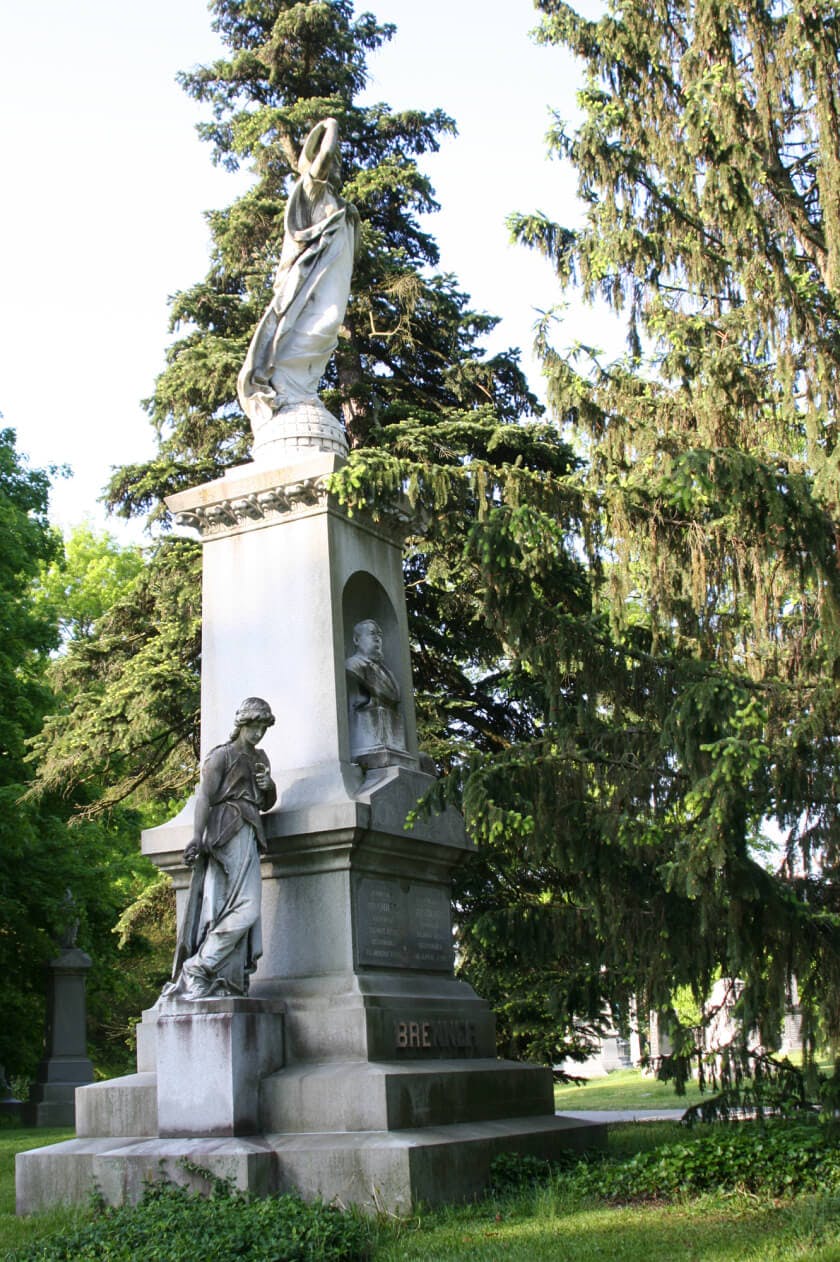
- Meet the Staff
- Career Opportunities
- Everlasting Floral Program
- Visitor's Guide
- COVID 19 Response
Public Tram Tour September 2024
Public Tram Tours are offered four times each month May through August and three times each in September and October. Your $5 donation will go to the Heritage Foundation to further efforts in education, preservation, and community outreach. Registration is required as space is limited. Registration will open for this tour on August 6, 2024 at noon.
TOUR TOPIC: ROOTED IN HISTORY, QUEST FOR PRESIDENTIAL TREES
Although no former U.S. President is buried at Spring Grove, the cemetery does have a connection with most of our Presidents through its extensive collection of trees. On this tour the docent will guide you to an encounter with each of these “Presidential Trees.” You will hear an explanation of the characteristics of each tree as well as how the tree is connected to a President.
Stay up to date
Sign up to get the latest information on current events at Spring Grove and to be notified of new products and services.
Minnesota Landscape Arboretum Tram Tour

An narrated historical tour of the Minnesota Landscape Arboretum highlighting the research and development of new plant and tree species with the Arboretum's partner, the University of Minnesota. Also featured were the different habitats found in Minnesota and restoration efforts for habitats/species native to Minnesota.
56 participated
Participants will learn about the 1) history of the Arboretum especially as it relates to the development of new plant species that survive and thrive in Minnesota's climate, 2) the various Minnesota habitats and efforts to preserve and restore them.
Participants learned about 1) the history and growth of the Arboretum from its early origins to the size and extent it is today, 2) the vast number of variety of plants and trees that were created in the U of M research labs at the Arboretum that are suited to Minnesota habitat, 3) habitat restoration and conservation efforts in the state.
Related Projects
Minnesota department of education.
1500 Highway 36 West Roseville, MN 55113-4266
View this agency's projects»
- Fund Overview
- Arts & Cultural Heritage Fund
- Clean Water Fund
- Environment & Natural Resources Trust Fund
- Outdoor Heritage Fund
- Parks & Trails Fund
- Project Search
- Project Map
- Opportunities
- Appropriations

IMAGES
COMMENTS
Tram Tours A tram tour is the perfect way to learn about the Arboretum's history, view a variety of landscapes and be introduced to the many plants in our 127-acres. The 40-minute continuous narrated tram tour begins and ends at the Gift Shop patio. Trams tours are offered: Wednesday - Friday* Tour times: 11am and […]
Open every day of the year except December 25 from 8:00 a.m. to 5:00 p.m. Admission is Free. 3501 New York Avenue, NE Washington, DC 20002. Tel: 202-245-4523. [email protected].
The U.S. National Arboretum is a research institution, public garden, and green oasis of 451-acres that sits on the shores of the Anacostia River in Washington, DC. Annually, over 650,000 visitors enjoy connecting with nature, plants, and science. Its science has resulted in important plant introductions resistant to disease and pests that benefit our nation's plant nursery landscape.
Your support is vital to the Arboretum, where the power of trees makes a positive impact on people's lives. Make a gift. Experience the beauty of The Morton Arboretum's 1,700 acres on a guided tram tour on the Acorn Express. This one-hour ride winds you through the Arboretum's woodlands, wetlands, and prairie while listening to a narrated tour.
The National Arboretum is located in the northeast section of Washington, DC, approximately 10 minutes from the Capitol Building. There are two entrances: one at 3501 New York Avenue, NE, and the other at 24th & R Streets, NE, off Bladensburg Road. From Northwest Washington: Follow New York Avenue east to the intersection of Bladensburg Road.
The U.S. National Arboretum is located at 3501 New York Avenue NE in Washington, DC. The grounds are open to the public from 8 a.m. to 5 p.m. every day of the year except Dec. 25. The Arboretum's popular National Bonsai & Penjing Museum is open from 10 a.m. to 4 p.m. every day except for federal holidays that fall from November through ...
See a guide to the National Arboretum in Washington, DC, explore 446 acres of trees, shrubs, and plants that are cultivated for science and education. ... Public Tours . A 40-minute tram ride with a taped narrative highlights the history and mission of 446 acres of gardens, collections and natural areas. ...
For the best results, wander north from the fields near Meadow Road and Valley Road, toward the pond near Hickey Lane. Pisano also notes that birding is best in the early morning, so he suggests ...
Travel Information. National Arboretum. 3501 New York Ave, NE. Washington, DC 20002. 202.245.2726. Hours: The Arboretum grounds are open every day of the year except December 25 from 8:00 a.m. to 5:00 p.m. The Visitor Center is open from 8:00 a.m. to 4:30 p.m.daily except for federal holidays November through February.
The tram tour highlights the 446 acres of the U.S. National Arboretum's gardens, collections and natural areas. During the 35-minute ride, you will hear an informative narrative about the Arboretum,...
Reviewed November 21, 2009. Visited the National Arboretum in D.C. today. Nearly a hundred thousand commuters drive on New York Avenue heading in and out of downtown DC but few realize they passing on the capital's major parks and even fewer ever visit it. This is a shame because the gardens of the park are one of the city's treasures.
Fodor's Expert Review United States National Arboretum. ... On weekends, a tram tours the arboretum's curving roadways at 11:30 and on the hour 1-4. Green Free Fodor's Choice Garden.
The grounds of the U.S. National Arboretum are open from 8 a.m. to 5 p.m. every day of the year except for Christmas Day. The National Bonsai & Penjing Museum is open 10 a.m. to 4 p.m. daily except for federal holidays from November through February. Admission to the grounds and museum is free and no tickets are needed. NEW SPRING 2024 TRAFFIC ...
You can bring bikes, hike, take a guided tram tour, or drive along the paved roadways to see the magnificent natural areas of the Arboretum. Find Tranquility Within the Arboretum's tree collections and trails, there are many opportunities to find a quiet spot to read a favorite book, connect with loved ones, or sit in peaceful reflection.
To schedule a tour, email us at [email protected] or call 206.543.8800. UW Botanic Gardens Tram Tour. Tour departs from: 2300 Arboretum Drive East, Seattle, WA 98112. Back to Top. Activities. Open Every day dawn to 8pm, free of charge. Visitors Center open limited hours. Location. 2300 Arboretum Drive E.
The United States National Arboretum The United States National Arboretum was established in 1927 to serve the public need for scientific research, education and gardens that conserve and showcase plants to enhance the environment. ... Public and private tram tours are available daily. For the most up to date tour information please visit ...
Holden Arboretum. Tram tour tickets are available for purchase on a first-come, first-served basis at the Corning Visitors Center on the day of your visit. Length: 45 minutes. Cost: $9 Adults (13+), $6 Children (3-12) Children 2 and under may ride in an adult's lap. Tram Tours have concluded for the season and will return in May of 2024.
Here's everything you need to know about visiting the Holden Arboretum: Address: 9550 Sperry Rd, Kirtland, OH 44094. Opening hours: 9 a.m.-5 p.m. daily (closed Thanksgiving, Christmas Eve, Christmas Day and New Year's Day) The Canopy Walk and Emergent Tower are open daily from April 1 through November 1.
§ 500.21 Fee schedule for tram and tours. The USNA provides tours of the USNA grounds in a 48-passenger tram (accommodating 2 wheelchairs). The fee is as follows: $4.00 per adult, $3.00 per senior citizen or Friend of the National Arboretum, and $2.00 per child under the age 17. Children under 4 sharing a seat with an adult will not be charged.
Updated: Apr 3, 2024 / 06:11 PM EDT. SARASOTA, Fla. (SNN) — Manatee County is launching a new tram tour at Robinson Preserve. The tour will let everyone, including those with physical limitations, get the chance to explore the park. "We have a lot of folks in our community who are aging they love nature and they love this preserve, but they ...
Join us for a narrated tram tour on Three-Mile Drive highlighting our varied collections, display gardens and our Farm at the Arb! Duration: Approximately 60 minutes Dates and Times: Tours run seasonally May-October at 10:30 a.m., noon, 1:30 p.m. and 3 p.m. daily (no 10:30 a.m. tour on Mondays). Tickets: Same-day tickets are available for purchase in person at the Visitor Center Information Desk.
Public Tram Tours are offered four times each month May through August and three times each in September and October. Your $5 donation will go to the Heritage Foundation to further efforts in education, preservation, and community outreach. Registration is required as space is limited. Registration will open for this tour on August 6, 2024 at noon.
1500 Highway 36 West. Roseville, MN 55113-4266. 651-582-8200. Visit the site. View this agency's projects». An narrated historical tour of the Minnesota Landscape Arboretum highlighting the research and development of new plant and tree species with the Arboretum's partner, the University of Minnesota. Also featured were the different habitats ...